ICOM orporated 334000 VHF Marine Transceiver User Manual IC M24 2 indd
ICOM Incorporated VHF Marine Transceiver IC M24 2 indd
User Manual
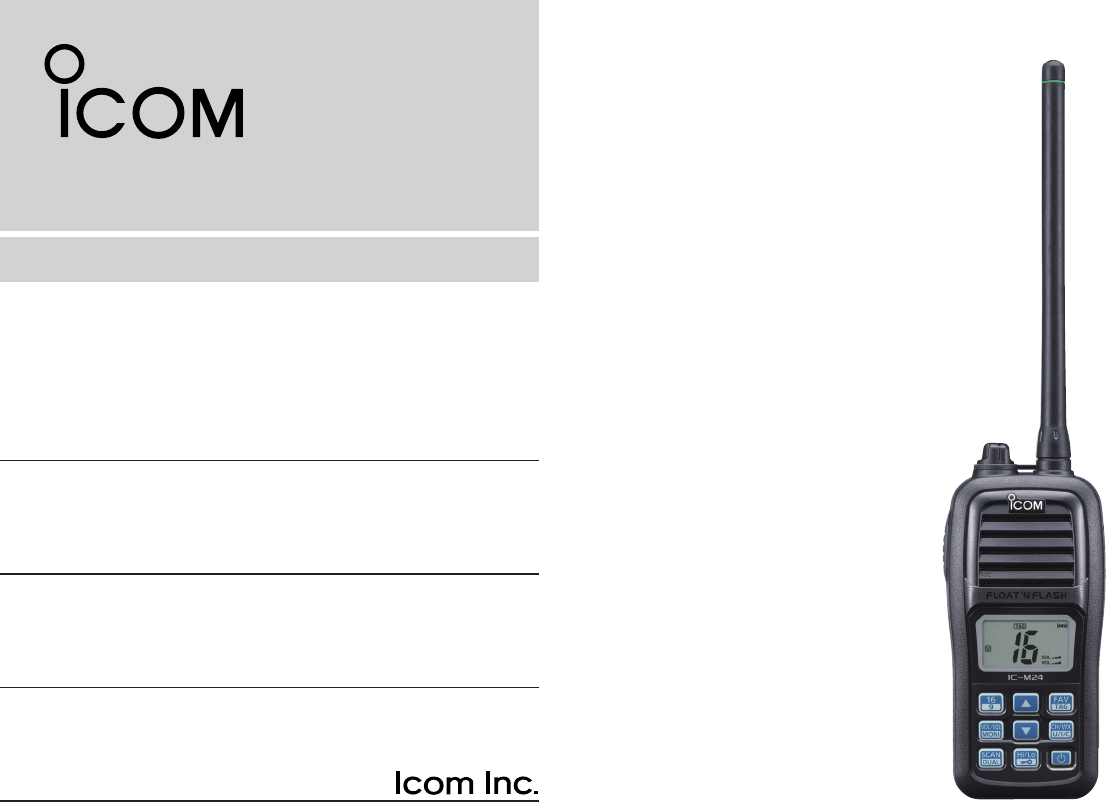
INSTRUCTION MANUAL
iM24
VHF MARINE TRANSCEIVER
This device complies with Part 15 of the FCC
Rules. Operation is subject to the condition that
this device does not cause harmful interference.
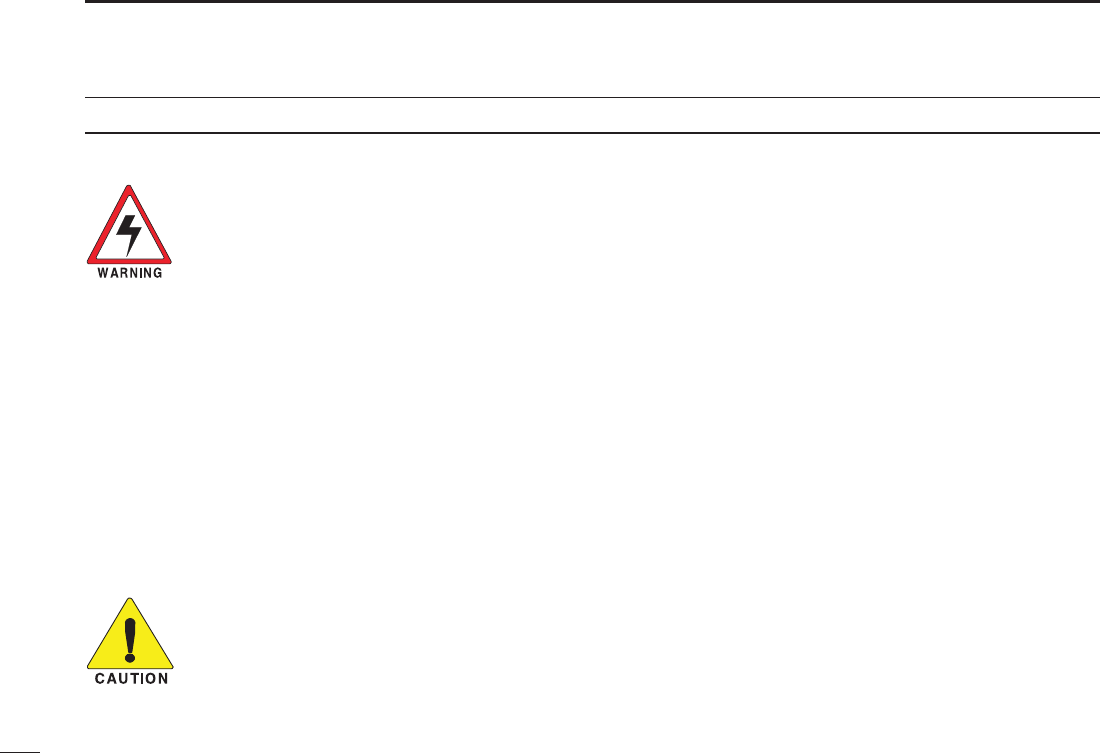
i
Your Icom radio generates RF electromagnetic energy during
transmit mode. This radio is designed for and classified as
“General Population Use” in an uncontrolled environment.
This radio has been evaluated for compliance at the distance
of 2.5 cm (1 inch) with the FCC RF exposure limits for “
Gen-
eral Population Use
”. In addition, your Icom radio complies
with the following Standards and Guidelines with regard to RF
energy and electromagnetic energy levels and evaluation of
such levels for exposure to humans:
• FCC OET Bulletin 65 Edition 01-01 Supplement C, Evaluating Compli-
ance with FCC Guidelines for Human Exposure to Radio Frequency
Electromagnetic Fields.
• American National Standards Institute (C95.1-1992), IEEE Standard
for Safety Levels with Respect to Human Exposure to Radio Frequency
Electromagnetic Fields, 3 kHz to 300 GHz.
• American National Standards Institute (C95.3-1992), IEEE Recom-
mended Practice for the Measurement of Potentially Hazardous Electro-
magnetic Fields– RF and Microwave.
• The following accessories are authorized for use with this product. Use of
accessories other than those specifi ed may result in RF exposure levels
exceeding the FCC requirements for wireless RF exposure.; Belt Clip
(MB-124), Rechargeable Li-Ion Battery Pack (BP-266).
To ensure that your expose to RF electromagnetic en-
ergy is within the FCC allowable limits for general popu-
lation use, always adhere to the following guidelines:
• DO NOT operate the radio without a proper antenna attached, as this
may damaged the radio and may also cause you to exceed FCC RF ex-
posure limits. A proper antenna is the antenna supplied with this radio by
the manufacturer or antenna specifi cally authorized by the manufacturer
for use with this radio.
• DO NOT transmit for more than 50% of total radio use time (“50% duty
cycle”). Transmitting more than 50% of the time can cause FCC RF expo-
sure compliance requirements to be exceeded. The radio is transmitting
when the “transmit indicator” appears on the LCD. You can cause the
radio to transmit by pressing the “PTT” switch.
• ALWAYS keep the antenna at least 2.5 cm (1 inch) away from the body
when transmitting and only use the Icom belt clip which is listed on p. 28
when attaching the radio to your belt, etc., to ensure FCC RF exposure
compliance requirements are not exceeded. To provide the recipients of
your transmission the best sound quality, hold the antenna at least 5 cm
(2 inches) from your mouth, and slightly off to one side.
The information listed above provides the user with the information needed
to make him or her aware of RF exposure, and what to do to assure that this
radio operates with the FCC RF exposure limits of this radio.
Electromagnetic Interference/Compatibility
During transmissions, your Icom radio generates RF energy that can possibly
cause interference with other devices or systems. To avoid such interference,
turn off the radio in areas where signs are posted to do so. DO NOT operate
the transmitter in areas that are sensitive to electromagnetic radiation such as
hospitals, aircraft, and blasting sites.
i
SAFETY TRAINING INFORMATION
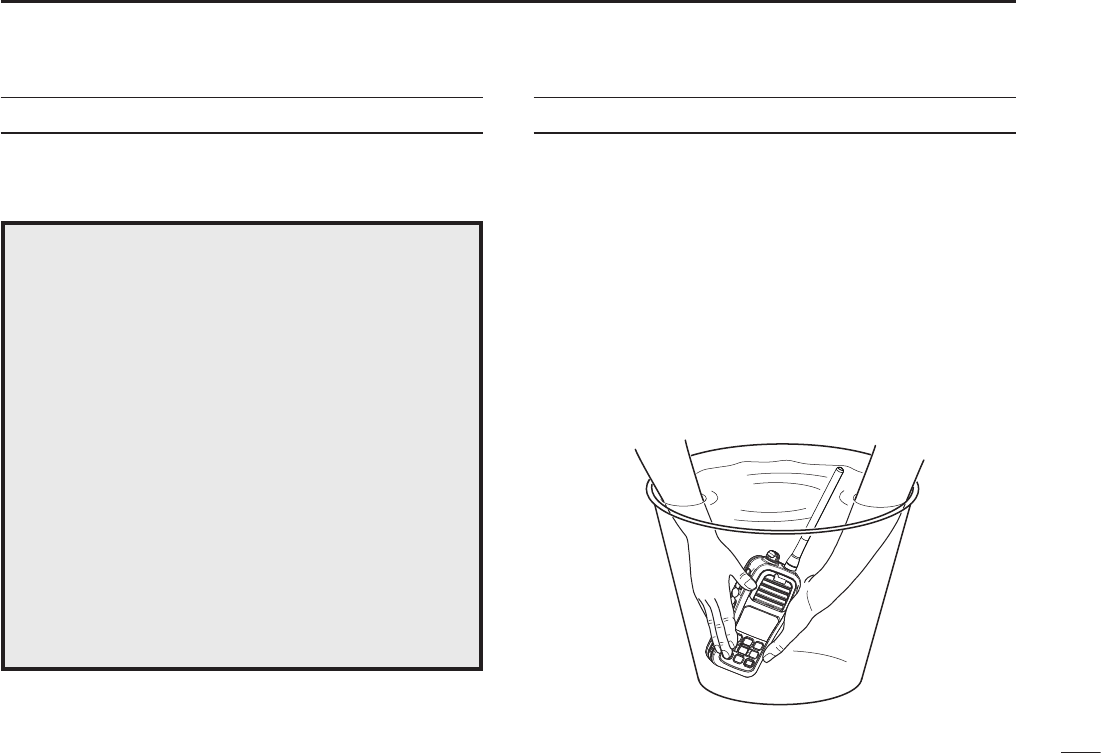
ii
IN CASE OF EMERGENCY RECOMMENDATION
If your vessel requires assistance, contact other vessels and
the Coast Guard by sending a distress call on Channel 16.
❍ USING CHANNEL 16
DISTRESS CALL PROCEDURE
1. “MAYDAY MAYDAY MAYDAY.”
2. “THIS IS ……………… ” (name of vessel)
3. Your call sign or other indication of the ves-
sel.
4. “LOCATED AT …………… ” (your position)
5. The nature of the distress and assistance
required.
6. Any other information which might facilitate
the rescue.
CLEAN THE TRANSCEIVER THOROUGHLY WITH FRESH
WATER after exposure to saltwater, and dry it before operat-
ing. Otherwise, the transceiver's keys, switches and control-
lers may become unusable due to salt crystallization.
NOTE: DO NOT submerge the transceiver in water if there
is any reason to suspect the waterproof protection may not
be effective. For example, in cases where the battery cover
or [DC] jack cap rubber seal is damaged, the transceiver/
battery cover/[DC] jack cap is cracked or broken, or the
transceiver has been dropped, or when the battery cover,
antenna or DC Jack cap are detached from the transceiver.
BP-266
BP-266
BP-266
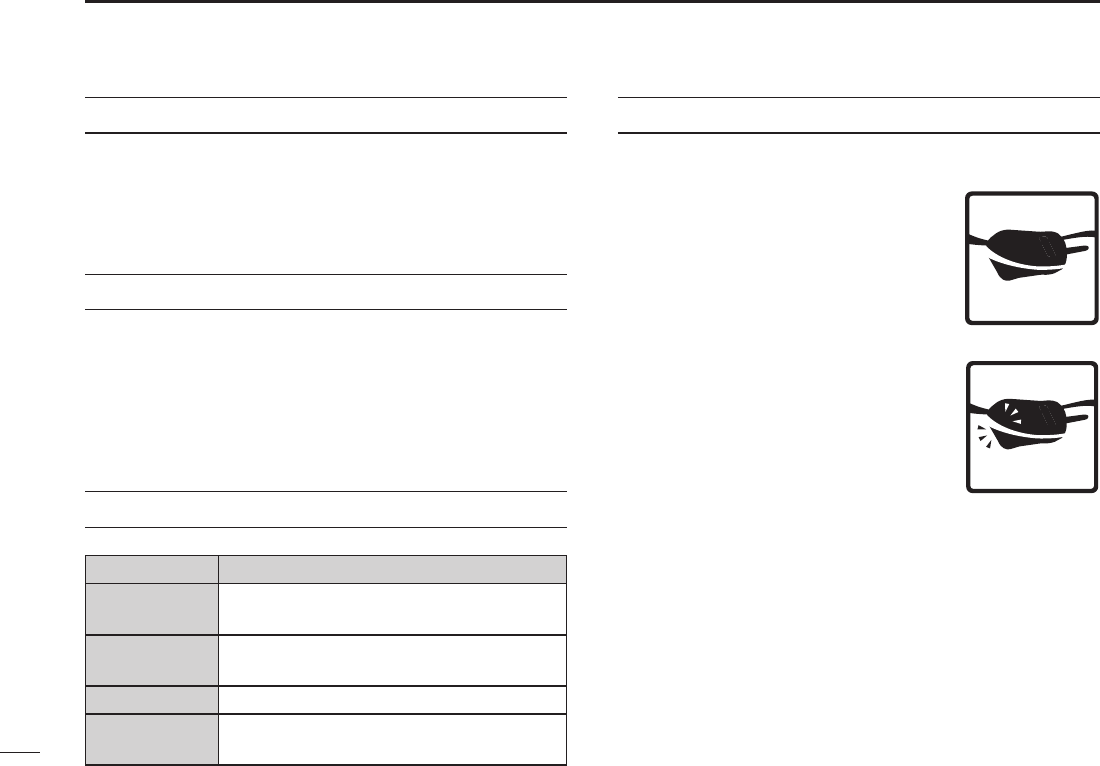
FOREWORD
Thank you for purchasing this Icom radio. The IC-M24 VHF
MARINE TRANSCEIVER is designed and built with Icom’s state of
the art technology and craftsmanship. With proper care this
radio should provide you with years of trouble-free operation.
IMPORTANT
READ ALL INSTRUCTIONS carefully and com-
pletely before using the transceiver.
SAVE THIS INSTRUCTION MANUAL—This
instruction manual contains important operating instructions
for the IC-M24.
EXPLICIT DEFINITIONS
WORD DEFINITION
RDANGER! Personal death, serious injury or an explo-
sion may occur.
RWARNING! Personal injury, fire hazard or electric
shock may occur.
CAUTION Equipment damage may occur.
NOTE
If disregarded, only inconvenience. No risk
of personal injury, fi re or electric shock.
FEATURES
☞ Floats on water
The transceiver floats in fresh or salt
water even when the supplied acces-
sories are attached.
• When a third-party battery pack, strap, an-
tenna, etc. is used, it may sink.
☞ Floats and fl ashes
An LED sends out intermittent light from
a transparent section on the bottom of
the radio, while floating in the water.
As the LED light stands out in the dark
(like a flashing fishing float), the radio
can be easily retrieved from the water.
This function works even when the radio
is turned OFF.
iii
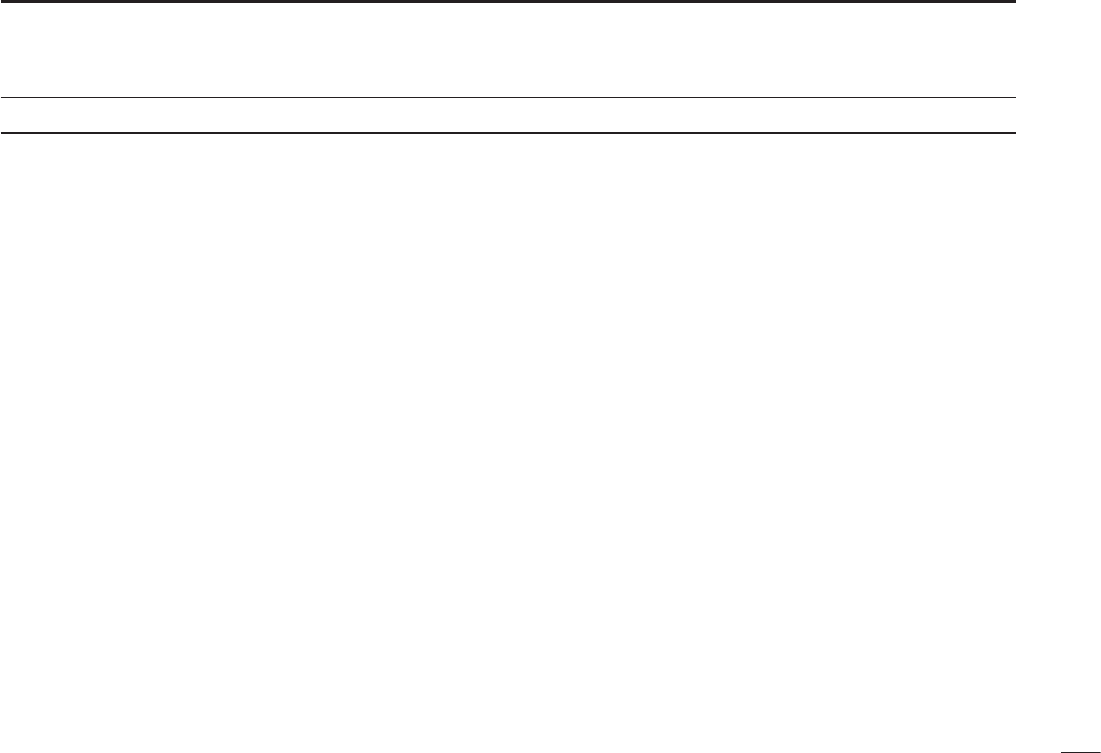
iv
RWARNING! NEVER connect the transceiver to an
AC outlet. This may pose a fi re hazard or result in an electric
shock.
RWARNING! NEVER hold the transceiver so that
the antenna is closer than 2.5 cm (1 inch) from exposed
parts of the body, especially the face or eyes, while transmit-
ting. The transceiver will perform best if the microphone is
5 to 10 cm (2 to 4 inches) away from the lips and the trans-
ceiver is vertical.
CAUTION: NEVER connect the transceiver to a
power source other than the BC-199 or BP-266. Such a con-
nection will ruin the transceiver.
DO NOT use or place the transceiver in direct sunlight
or in areas with temperatures below –20°C (–4°F) or above
+60°C (+140°F).
KEEP the transceiver out of the reach of children.
KEEP the transceiver at least 0.9 meters (3.0 ft) away
from your vessel’s magnetic navigation compass.
BE CAREFUL! The transceiver meets IPX7* require-
ments for waterproof protection. However, once the trans-
ceiver has been dropped, waterproof protection cannot be
guaranteed because of possible damage to the transceiver's
case or the waterproof seal.
* Only when the flexible antenna, battery cover and [DC] jack cap
are securely attached.
MAKE SURE the fl exible antenna and battery cover are
securely attached to the transceiver, and that the antenna
and battery cover are dry before attachment. Exposing the
inside of the transceiver to water will result in serious dam-
age to the transceiver.
Icom, Icom Inc. and the Icom logo are registered trademarks of Icom Incor-
porated (Japan) in Japan, the United States, the United Kingdom, Germany,
France, Spain, Russia and/or other countries.
PRECAUTIONS
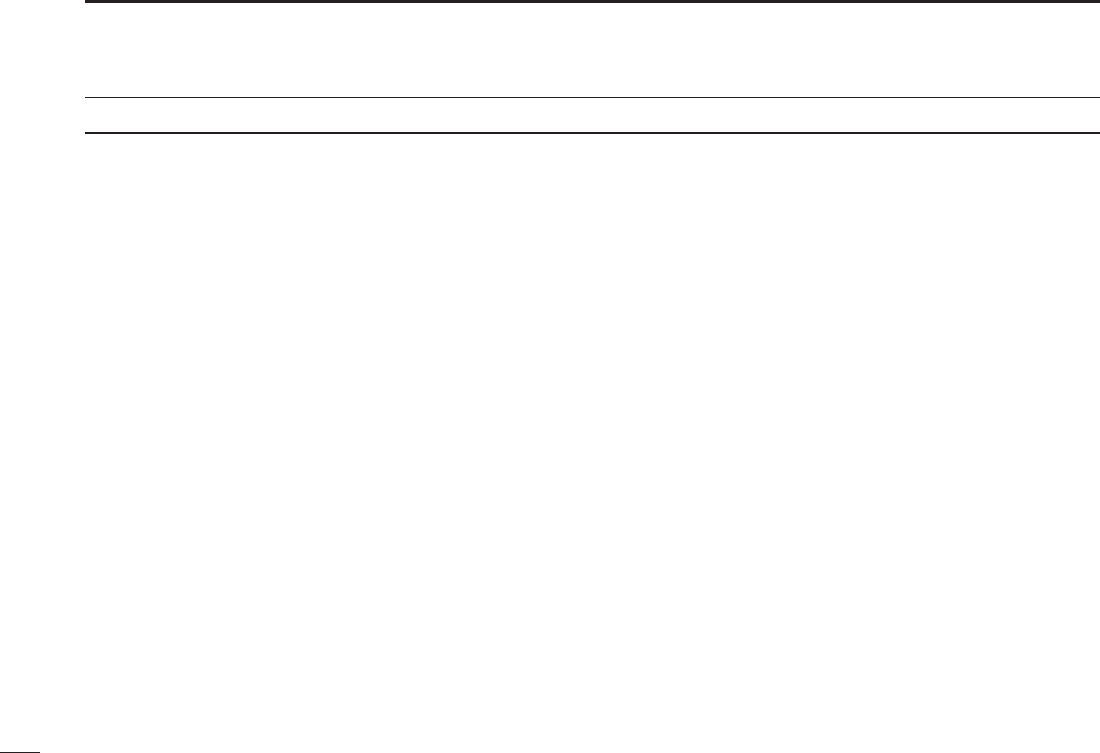
v
SAFETY TRAINING INFORMATION ................................................. i
IN CASE OF EMERGENCY ............................................................. ii
RECOMMENDATION ....................................................................... ii
FOREWORD ................................................................................... iii
IMPORTANT .................................................................................... iii
EXPLICIT DEFINITIONS ................................................................. iii
FEATURES ...................................................................................... iii
PRECAUTIONS ............................................................................... iv
TABLE OF CONTENTS .................................................................... v
1 OPERATING RULES ..................................................................1
2 SUPPLIED ACCESSORIES AND ATTACHMENTS ...............2–3
■ Supplied accessories ...............................................................2
■ Attachments .............................................................................2
3 PANEL DESCRIPTION ...........................................................4–7
■ Front, top and side panels .......................................................4
■ Function display .......................................................................6
4 BASIC OPERATION .............................................................8–13
■ Channel selection ....................................................................8
■ Adjusting the volume level .....................................................10
■ Adjusting the squelch level ....................................................10
■ Receiving and transmitting ....................................................11
■ Call channel programming ..................................................... 12
■ Volume Loud function ............................................................12
■ Volume Mute function ............................................................12
■ Lock function ..........................................................................13
■ Monitor function .....................................................................13
■ Automatic backlighting ...........................................................13
■ AquaQuake Water Draining function......................................13
5 SCAN OPERATION ............................................................14–15
■ Scan types ............................................................................. 14
■ Setting TAG channels ............................................................15
■ Starting a scan .......................................................................15
6 DUALWATCH/TRI-WATCH .......................................................16
■ Description .............................................................................16
■ Operation ............................................................................... 16
7 SET MODE ..........................................................................17–20
■ Set mode programming .........................................................17
■ Set mode items ......................................................................18
8 BATTERY CHARGING .......................................................21–25
■ Battery caution .......................................................................21
■ Supplied battery charger .......................................................23
■ Optional battery charger ........................................................23
9 TROUBLESHOOTING .............................................................. 26
10 VHF MARINE CHANNEL LIST .................................................27
11 SPECIFICATIONS AND OPTIONS ...........................................28
■ Specifi cations.........................................................................28
■ Options ..................................................................................28
13 FCC INFORMATION .................................................................29
TABLE OF CONTENTS
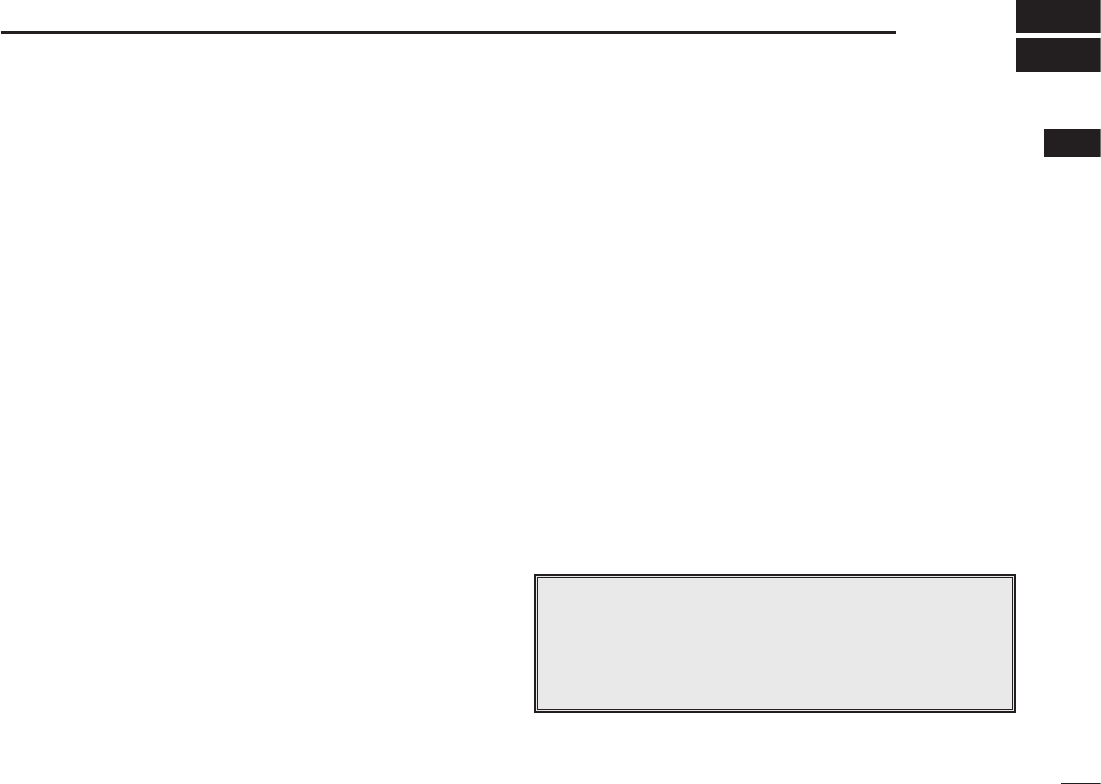
D Priorities
• Read all rules and regulations pertaining to call priorities,
and keep an up-to-date copy handy. Safety and distress
calls take priority over all others.
• You must monitor Channel 16 when you are not operating
on another channel.
• False or fraudulent distress calls are prohibited under law.
D Privacy
• Information overheard, but not intended for you, cannot
lawfully be used in any way.
• Indecent or profane language is prohibited.
D Radio licenses
(1) SHIP STATION LICENSE
You may require a current radio station license before using
the transceiver. It is unlawful to operate a ship station which
is not licensed, but required to be.
If required, contact your dealer or the appropriate govern-
ment agency for a Ship-Radiotelephone license application.
This government-issued license states the call sign which is
your craft’s identifi cation for radio purposes.
(2) OPERATOR’S LICENSE
A Restricted Radiotelephone Operator Permit is the license
most often held by small vessel radio operators when a radio
is not required for safety purposes.
If required, the Restricted Radiotelephone Operator Permit
must be posted or kept with the operator. If required, only a
licensed radio operator may operate a transceiver.
However, non-licensed individuals may talk over a trans-
ceiver if a licensed operator starts, supervises, ends the call
and makes the necessary log entries.
A current copy of the applicable government rules and regu-
lations is only required to be on hand for vessels in which a
radio telephone is compulsory. However, even if you are not
required to have these on hand it is your responsibility to be
thoroughly acquainted with all pertinent rules and regula-
tions.
NOTE: Even though the IC-M24 is capable of operation
on VHF marine channels 3, 21, 23, 61, 64, 81, 82 and
83, according to FCC regulations these simplex channels
cannot be lawfully used by the general population in USA
waters.
1
1
OPERATING RULES
1
2
3
4
5
6
7
8
9
10
11
12
13
14
15
16
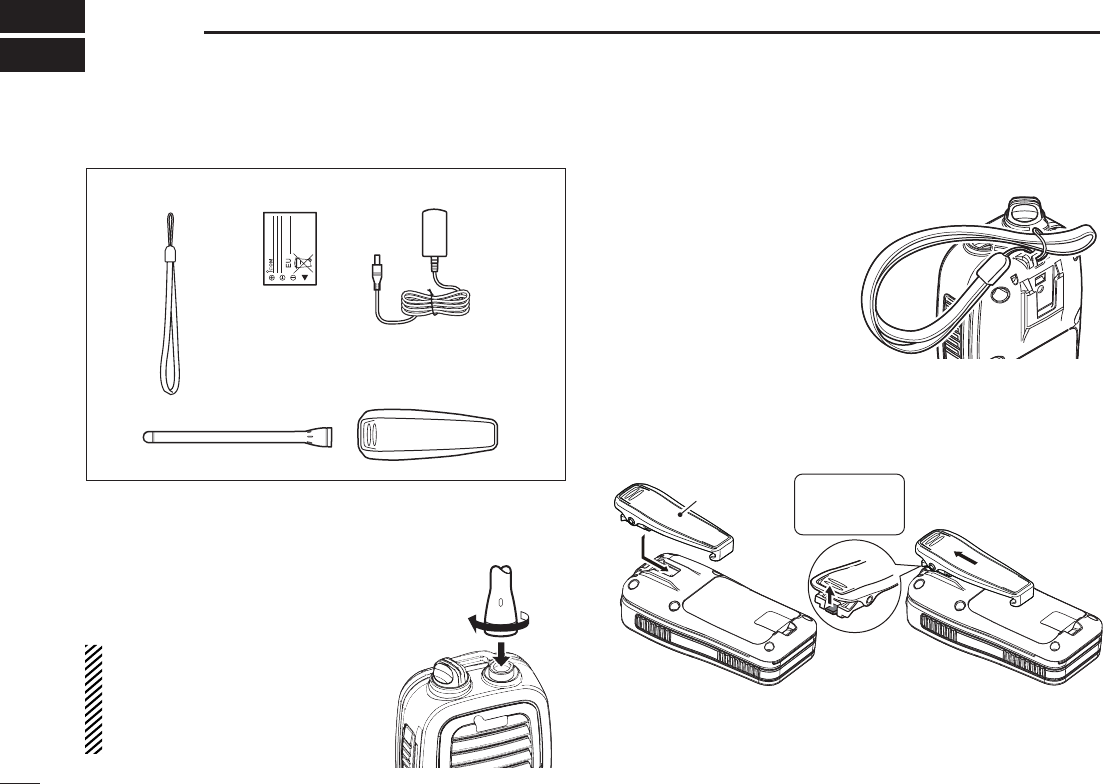
2
SUPPLIED ACCESSORIES AND ATTACHMENTS
2
■ Supplied accessories
■ Attachments
D Flexible antenna
Connect the supplied flexible an-
tenna to the antenna connector.
CAUTION:
• NEVER carry the transceiver by
holding just the antenna.
• Transmitting without an antenna
can damage the transceiver.
D Handstrap
Pass the handstrap through
the loop on the back side of
the transceiver as shown.
D Belt clip
Attach the belt clip to, or detach the belt clip from the transceiver.
Battery packHandstrap
Belt clip
Flexible antenna
Charger
BP-266
BP-266
BP-266
BP-266
BP-266
BP-266
BP-266
BP-266
BP-266
To attach the belt clip To detach the belt clip
Be careful!
Don’t break your
fingernail.
q
Belt clip
w
BP-266
BP-266
Lift the tab up (q), and slide
the belt clip in the direction
of the arrow (w).
BP-266
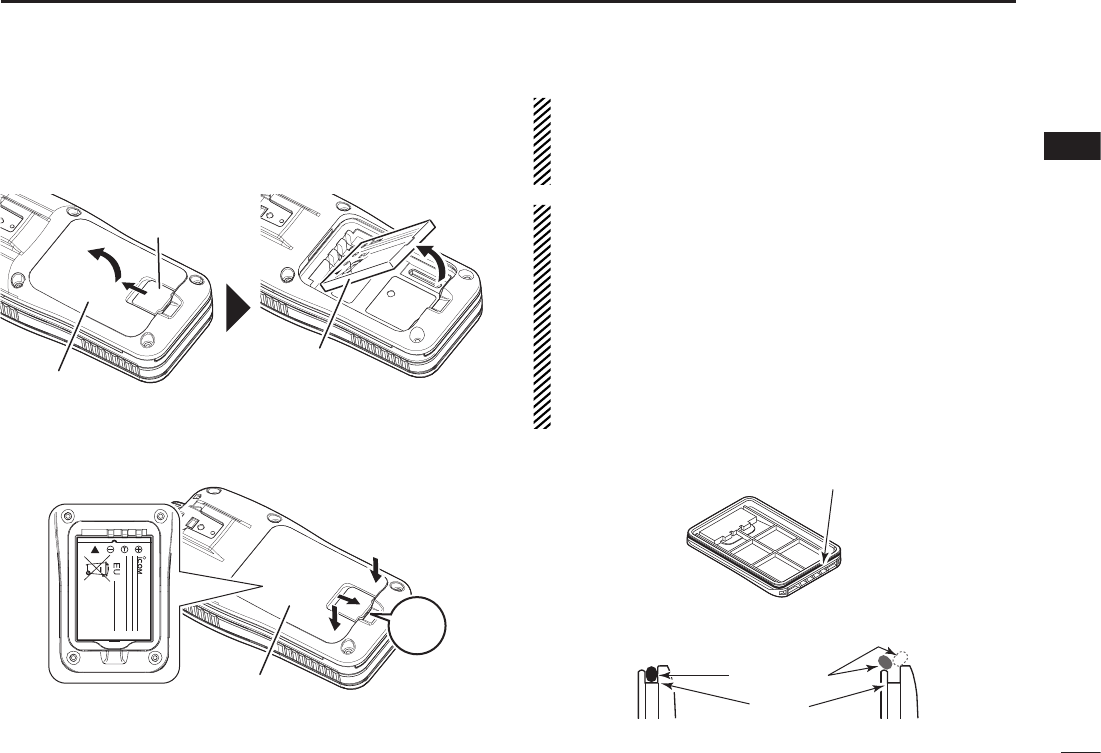
Make sure the rubber seal is properly seated in the
groove and there is dust or other material is on it.
BP-266
BP-266
Rubber seal
Groove
Battery cover Battery cover
Correct position Incorrect position
BP-266
D Battery pack
To remove the battery pack:
Slide the latch and then lift the battery cover to remove it.
Then remove the battery pack, as shown.
To insert the battery pack:
Place the battery pack into the transceiver so it fi ts fl at, and
then securely attach
the battery cover, as shown.
NEVER remove the
battery cover
when the transceiver is
wet or soiled. This may result in water or dust getting into
the transceiver/battery pack, and may result in the trans-
ceiver being damaged.
CAUTION:
•
When attaching or removing the battery cover, make sure
the rubber seal is correctly set in the groove of the cover.
If the seal is not correctly in the groove, it may be dam-
aged when attaching the battery cover. If the seal is dam-
aged, waterproof protection is not guaranteed.
•
When attaching the battery cover, make sure dust or
other material does not adhere to the rubber seal. If dust
or other material is on the seal when attaching the battery
cover, waterproof protection may not be guaranteed.
3
2
SUPPLIED ACCESSORIES AND ATTACHMENTS
1
2
3
4
5
6
7
8
9
10
11
12
13
14
15
16
BP-266
BP-266
Latch
Battery cover
BP-266
BP-266
BP-266
Push the cover until
the latch comes back
to the locked position.
Battery cover
“Click”
BP-266
BP-266
BP-266
Battery pack
BP-266
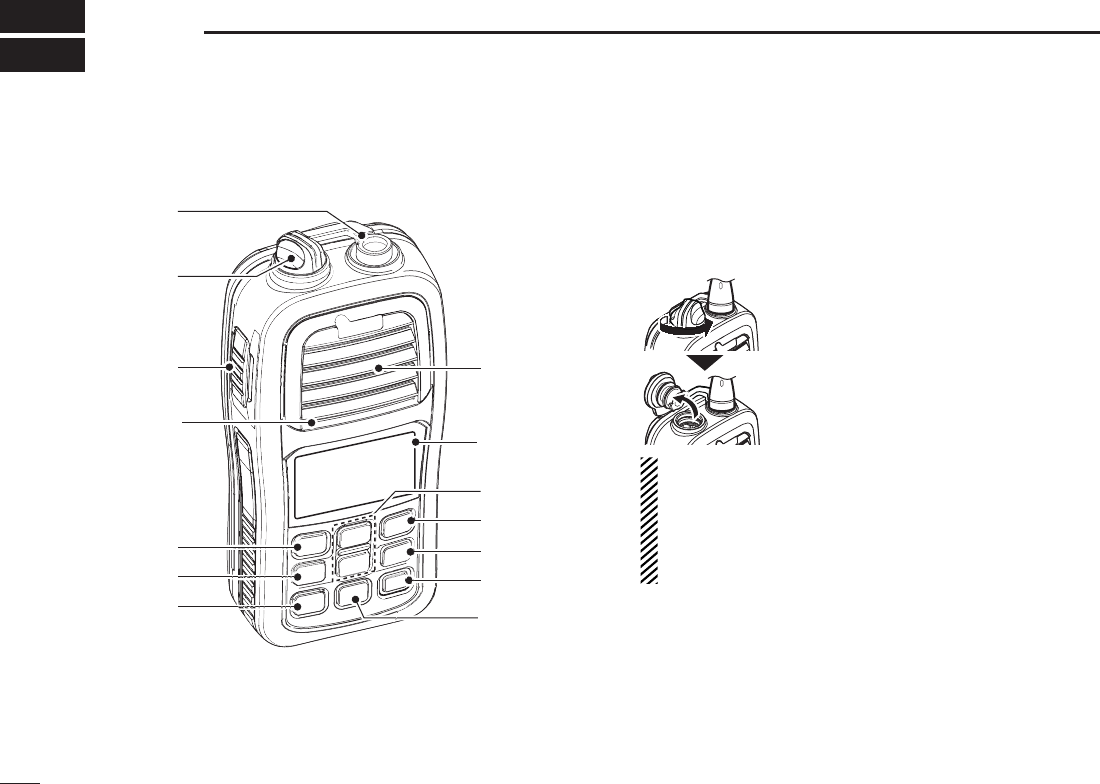
4
PANEL DESCRIPTION
3
■
Front, top and side panels
q ANTENNA CONNECTOR (p. 2)
Connect the supplied antenna here.
w
DC JACK [DC] (p. 23)
Connect the charger or optional cable here.
NOTE: Attach the [DC] jack cap when the charger or op-
tional cable is not connected. Otherwise, water will get into
the transceiver. When attaching the [DC] jack cap, make
sure dust or other material does not adhere to the rubber
seal. If dust or other material is on the seal when attaching
the cap, waterproof protection may not be guaranteed.
e PTT SWITCH [PTT]
Hold down to transmit; release to receive. (p. 11)
r CHANNEL 16 KEY [16 9]
➥ Push to select Channel 16. (p. 8)
➥
Hold down for 1 second to select the Call channel. (p. 8)
➥
When the Call channel is selected, hold down for 3 seconds
to enter the Call channel programming mode. (p. 12)
➥ While in the Set mode, push to return to the normal op-
erating mode. (p. 17)
Function
display
(pp. 6, 7)
Speaker
y
t
r
e
u
w
q
!1
o
i
!0
Microphone
BP-266
BP-266
BP-266
q To remove the
[DC]
jack cap, rotate it
counter clockwise.
BP-266
BP-266
BP-266
w Pull the cap up to detach it.
BP-266
BP-266
BP-266
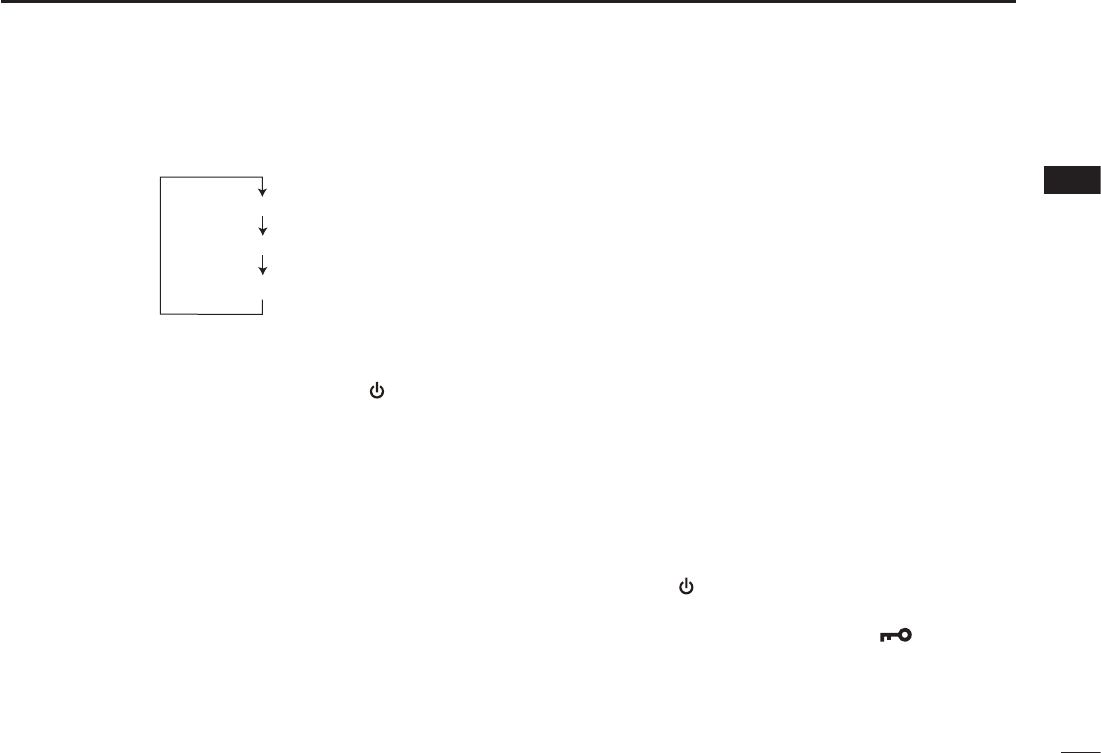
t VOLUME/SQUELCH/MONITOR KEY [VOL/SQL MONI]
➥ Push to enter the volume adjustment mode or the
squelch adjustment mode. (p. 10)
➥ Hold down for 1 second to activate the Monitor func-
tion. (p. 13)
➥ While holding down this key, hold down [] to turn ON
the power and enter the Set mode. (p. 17)
➥ While in the Set mode, push to select an item. (p. 17)
➥ While holding down this key, push [Z] to turn ON the
Volume Mute function. Do the same steps again to turn
OFF the function. (p. 12)
➥ While holding down this key, push [Y] to turn ON the
Volume Loud function. Do the same steps again to turn
OFF the function. (p. 12)
y SCAN/DUAL KEY [SCAN DUAL]
➥ Push to start or stop a normal or priority scan. (p. 15)
➥
Hold down for 1 second to enter the Dual/Tri-watch
mode. (p. 16)
➥ Push to exit the watch mode. (p. 16)
➥ Hold down this key and
[Hi/Lo]
for 1 second, to activate
the Aq
uaQuake function. (p. 13)
u UP/DOWN KEYS [Y] or [Z]
➥ Push to select an operating channel. (pp. 8, 9)
➥ While in the Set mode, push to select the setting or
value of an item. (p. 17)
➥ Push to check TAG channels or change scanning direc-
tion during a scan. (p. 15)
i FAVORITE/TAG KEY [FAV TAG]
➥ Push to sequentially select the favorite (TAG) chan-
nels, while ignoring untagged channels, in a channel
group. (p. 8)
➥ Hold down for 1 second to set or clear the TAG for the
displayed channel. (p. 15)
➥ While holding down, turn ON the power to clear or set
all TAG channels in the selected channel group. (p. 15)
o CHANNEL/WEATHER CHANNEL KEY [CH/WX U/I/C]
➥ Push to switch between a regular channel and a
weather channel. (p. 9)
➥ Hold down for 1 second to select the USA, International
and Canada channel groups. (p. 9)
➥ Push to return to the previous channel before selecting
Channel 16 or the Call channel. (p. 8)
!0 POWER KEY [ ]
Hold down to turn power ON or OFF.
!1 TRANSMIT POWER/LOCK KEY [Hi/Lo ]
➥
Push to
select the
high
or
low
output power
.
(p. 11)
➥ Hold down for 1 second to turn the Lock function ON or
OFF. (p. 13)
5
3
PANEL DESCRIPTION
1
2
3
4
5
6
7
8
9
10
11
12
13
14
15
16
Volume adjustment mode
Normal operating mode
Squelch adjustment mode
PUSH
PUSH
PUSH
BP-266
BP-266
BP-266
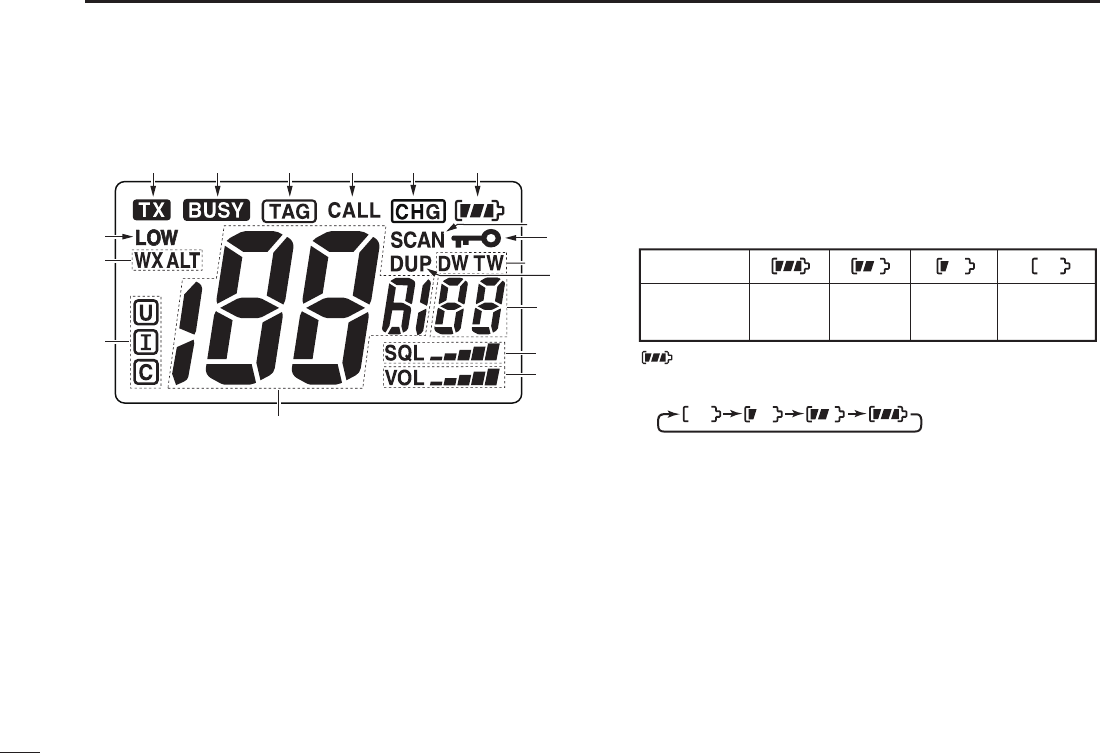
6
3PANEL DESCRIPTION
■ Function display
q TRANSMIT ICON (p. 11)
Appears while transmitting.
w BUSY ICON
➥ Appears while receiving a signal or when the squelch
opens. (p. 11)
➥ Blinks while monitoring. (p. 13)
e TAG CHANNEL ICON (p. 15)
Appears when a TAG channel is selected.
r CALL CHANNEL ICON (p. 8)
Appears when the Call channel is selected.
t CHARGE ICON (p. 23)
Appears while charging.
y BATTERY ICONS
➥ Displays the remaining battery capacity.
Indication
Full Middle Charging
required Exhausted
Battery status
blinks when the battery is over charged.
BP-266
BP-266
BP-266
➥ Scrolls while charging. (p. 23)
u SCAN ICON (p. 15)
Blinks during a scan.
i LOCK ICON (p. 13)
Appears when the Lock function is turned ON.
o DUALWATCH/TRI-WATCH ICONS (p. 16)
“DW” appears during Dualwatch; “TW” appears during Tri-
watch.
!0 DUPLEX ICON
Appears when a duplex channel is selected.
!4
!3
i
u
o
!2
!1
!0
!7
!5
qerytw
!6
BP-266
BP-266
BP-266
BP-266
BP-266
BP-266

!1 SUB CHANNEL READOUT
➥ Displays Channel 16 during a priority scan, Dualwatch
or Tri-watch. (p. 16)
➥ Displays the Set mode item while in the Set mode. (p. 17)
➥ Displays the volume level while in the volume adjust-
ment mode. (p. 10)
➥ Displays the squelch level while in the squelch adjust-
ment mode. (p. 10)
!2 SQUELCH LEVEL ICON
➥ Displays the squelch level.
➥ “ SQL” blinks while adjusting the squelch level. (p. 10)
!3 VOLUME LEVEL ICON
➥ Displays the volume level.
➥ The bars repeatedly appear in ascending order when
the Volume Loud function is turned ON. (p. 12)
➥ Blinks while the volume mute is turned ON. (p. 12)
➥ “ VOL” blinks while adjusting the volume level. (p. 10)
!4 CHANNEL NUMBER READOUT
➥ Displays the selected operating channel number.
➥
In the Set mode, displays the selected setting or value.
(p. 17)
!5 CHANNEL GROUP ICON (p. 9)
“” appears when USA; “ ” appears when International;
“” appears when Canadian channel group is selected.
!6 WEATHER CHANNEL/WEATHER ALERT ICONS (p. 9)
➥ “WX” appears when the weather channel group is se-
lected.
➥ “WX ALT” appears while the Weather Alert function is
turned ON; blinks when the alert tone is received.
!7 LOW POWER ICON (p. 11)
➥ “ LOW” appears when low power is selected.
➥ “LOW” blinks when switching to the low power mode is
forced because of a high temperature error or low volt-
age.
7
3
PANEL DESCRIPTION
1
2
3
4
5
6
7
8
9
10
11
12
13
14
15
16
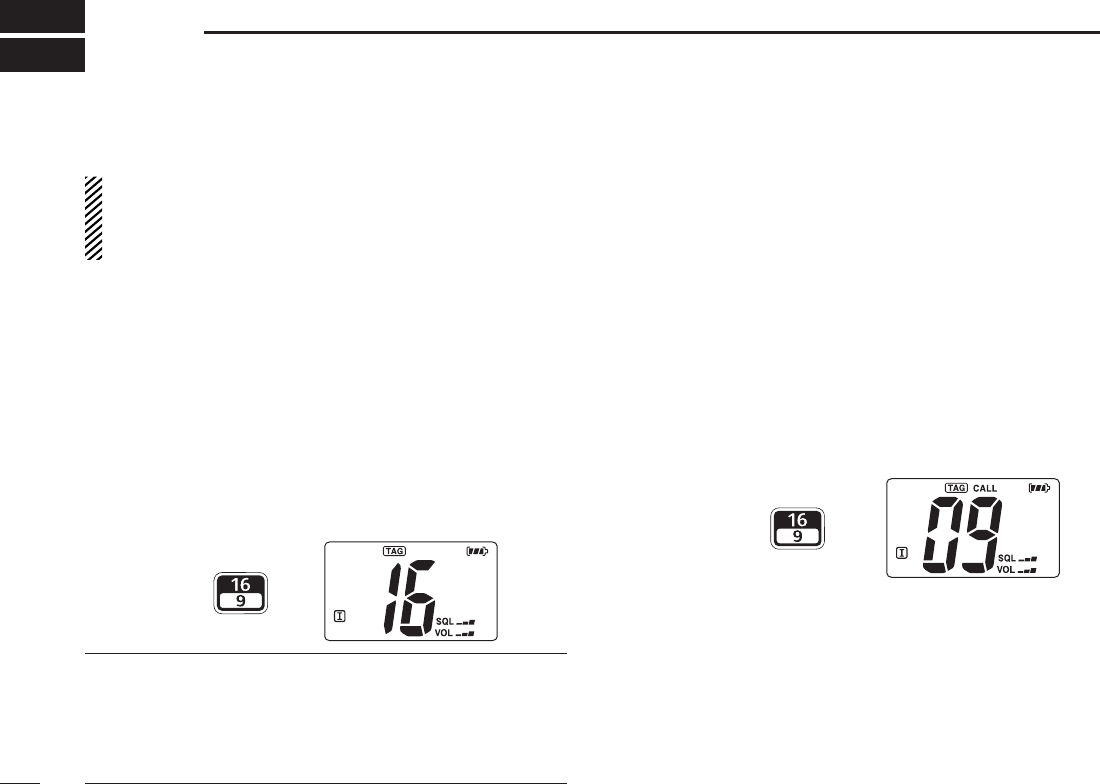
8
BASIC OPERATION
4
■ Channel selection
IMPORTANT: Prior to using the transceiver for the first
time, the battery pack must be fully charged for optimum
life and operation (p. 23). To avoid damage to the trans-
ceiver, turn OFF the power while charging.
D Channel 16
Channel 16 is the distress and safety channel. It is used for
establishing initial contact with a station, and for emergency
communications. Channel 16 is monitored during both Du-
alwatch and Tri-watch. While in the standby mode, you must
monitor Channel 16.
q Push [16] momentarily to select Channel 16.
w Push [CH/WX] to return to the channel used before se-
lecting Channel 16, or push [Y] or [Z] to select a differ-
ent channel.
Convenient!
While holding down [FAV], push [Y] or [Z] to select the fa-
vorite (TAG) channels.
• Pushing [FAV] only advances the displayed TAG channel.
• The favorite channels are selected using the TAG channel setting.
(p. 15)
D Channel 9 (Call channel)
Each regular channel group has a separate leisure-use Call
channel. The Call channel is monitored during Tri-watch. The
Call channels can be programmed, and are used to store
your most often used channel in each channel group, for
quick recall. (p. 12)
q Hold down [9] (16) for 1 second to select the Call channel
of the selected channel group.
• “CALL” and the Call channel number appear.
w Push [CH/WX] to return to the channel used before se-
lecting the Call channel, or push [Y] or [Z] to select a
different channel.
Push
Hold down
for 1 second
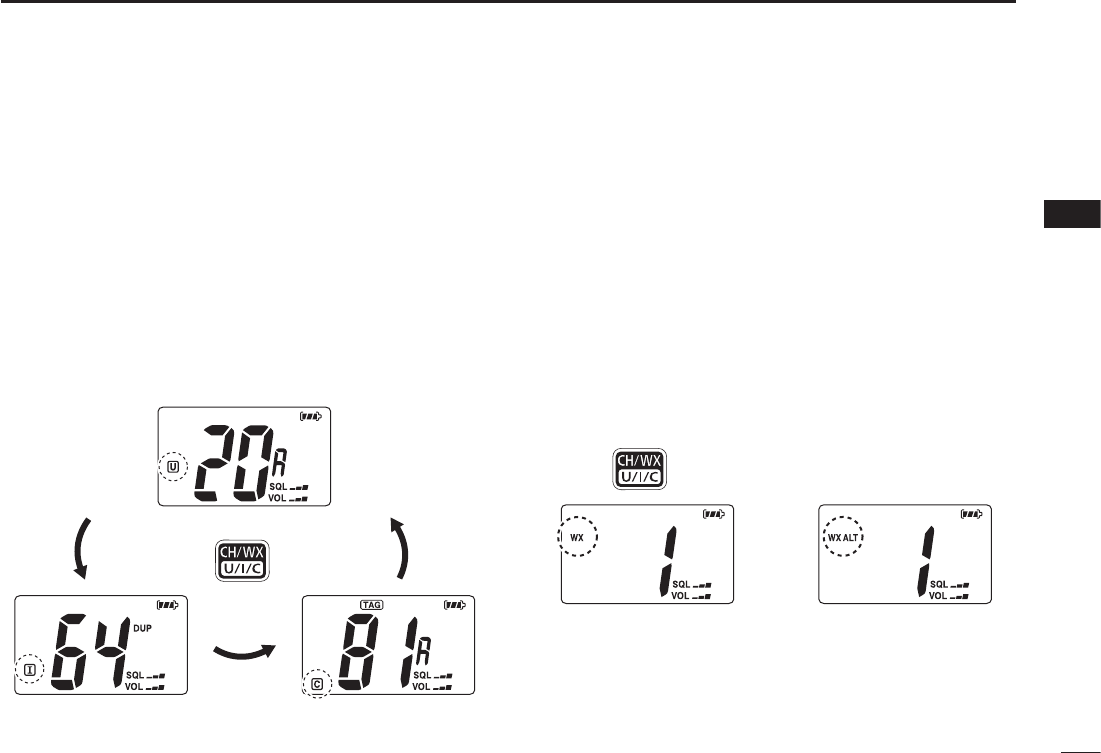
D USA, International and Canadian channels
The transceiver is pre-programmed with 59 USA, 61 Inter-
national and 65 Canadian channels. Choose the appropriate
channel groups for your operating area.
q Push [CH/WX] to select a regular channel.
• If a weather channel appears, push [CH/WX] again.
w Hold down [U/I/C] (CH/WX) for 1 second to change the
channel group. Repeat to advance to the next group.
• USA, International and Canadian channel groups can be se-
quentially selected.
e Push [Y] or [Z] to select a channel.
• “DUP” appears for duplex channels.
• “A” appears when a simplex channel is selected.
D Weather channels
The transceiver has 10 weather channels. These are used
for monitoring broadcasts from NOAA (National Oceanic and
Atmospheric Administration).
The transceiver can automatically detect a weather alert
tone on the selected weather channel while receiving an-
other channel, or during a scan. (p. 18)
q Push [CH/WX] once or twice to select the Weather chan-
nel group.
• “WX” appears when a weather channel is selected.
• “WX ALT” appears when the Weather Alert function is turned
ON. (p. 18)
w Push [Y] or [Z] to select a weather channel.
9
4
BASIC OPERATION
1
2
3
4
5
6
7
8
9
10
11
12
13
14
15
16
Hold down
U.S.A. channels
International channels Canadian channels
for 1 second
Push once or twice.
Weather Alert is OFF. Weather Alert is ON.
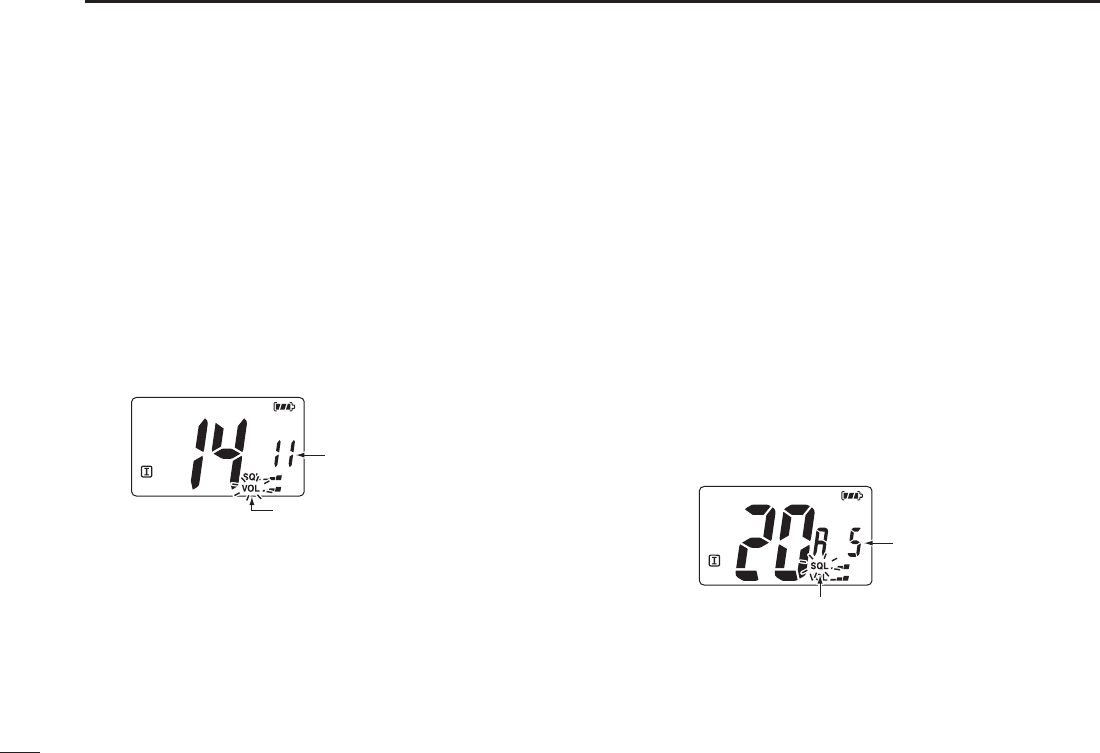
10
4BASIC OPERATION
■ Adjusting the volume level
The volume level can be adjusted using [VOL/SQL] and [Y]
or [Z].
q
Push [VOL/SQL] once to enter the volume adjustment
mode, then push [Y] or [Z] to adjust the volume level.
• The “VOL” icon starts blinking.
• The transceiver has 31 volume levels and OFF.
• When no key operation is performed for 5 seconds, the trans-
ceiver returns to the normal mode.
w Push
[VOL/SQL]
twice to exit the volume adjustment
mode.
■ Adjusting the squelch level
The squelch level can be adjusted using [VOL/SQL] and [Y]
or [Z].
In order to properly receive signals, as well as for the scan
to effectively function, the squelch must be adjusted to the
proper level.
q
Push
[VOL/SQL]
twice to enter the squelch adjustment
mode, then push [Y] or [Z] to adjust the squelch level.
• The “SQL” icon starts blinking.
• The transceiver has 11 squelch levels: OP is completely open;
10 is tight squelch; 1 is loose squelch.
• When no key operation is performed for 5 seconds, the trans-
ceiver returns to the normal mode.
w Push
[VOL/SQL]
again to exit the squelch adjustment
mode.
Displays the
volume level.
Blinks in the volume adjustment mode.
Displays the
squelch level.
Blinks in the squelch adjustment mode.
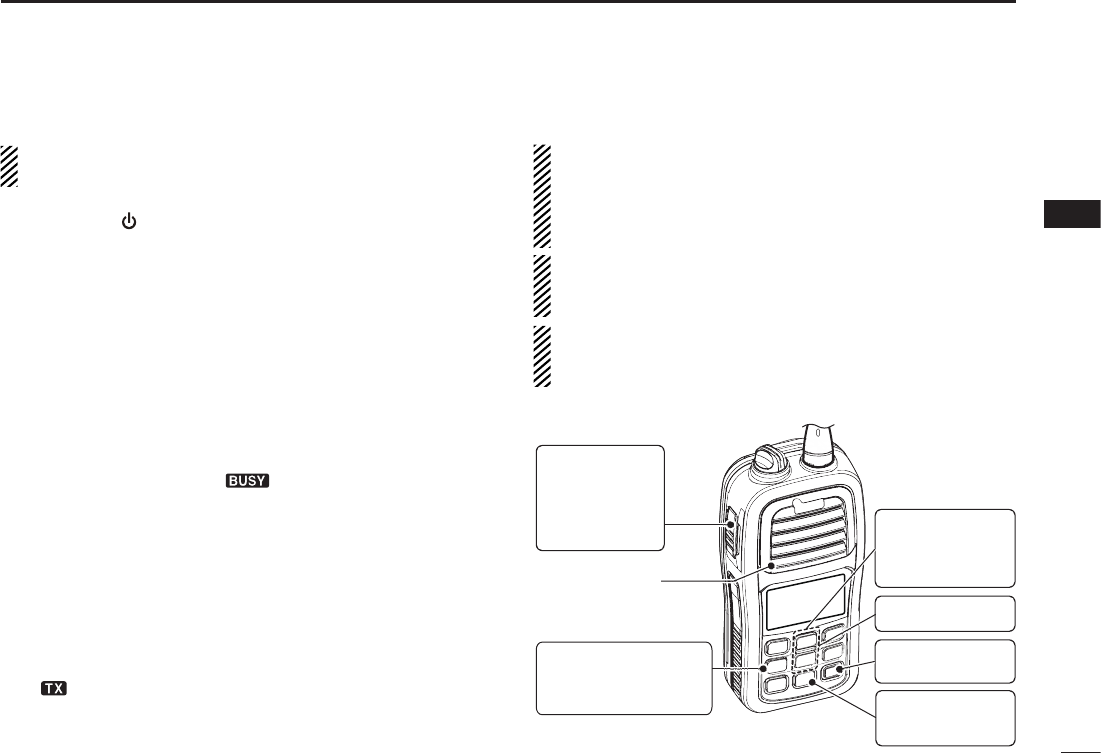
■ Receiving and transmitting
CAUTION: Transmitting without an antenna can damage
the transceiver.
q Hold down [] to turn ON the power.
w Set the volume and squelch levels.
You can enter each adjustment mode by pushing [VOL/
SQL].
➥ Enter the squelch adjustment mode, and then push [Z] one or
more times to open the squelch.
➥ Enter the volume adjustment mode, and then push [Y] or [Z]
to adjust the volume level.
➥ Enter the squelch adjustment mode again, and push [Y] until
the noise just disappears.
e
Push [VOL/SQL] again to exit the squelch adjustment mode.
r Push [Y] or [Z] to select a desired channel.
• When receiving a signal, “ ” appears and audio is heard
from the speaker.
• You may want to further adjust the audio level.
t Push [Hi/Lo] to select the output power if necessary.
• “LOW” appears when low power is selected; no icon is
displayed when high power is selected.
• Choose low power for short range communications; choose
high power for longer distance communications.
• Some channels are for only low power communication.
y
Hold down [PTT] to transmit, then speak into the microphone.
• “ ” appears.
• Channel 70 cannot be used for transmission.
u Release [PTT] to receive.
IMPORTANT: To maximize the readability of your trans-
mitted signal, pause for a second after pushing [PTT],
hold the microphone 5 to 10 cm (2 to 4 inches) from your
mouth and speak into the microphone at a normal voice
level.
NOTE: To conserve battery power, the transceiver’s
Power Save function automatically activates when no sig-
nal is received for 5 seconds.
For U.S.A version: To prevent prolonged transmission, a
time-out timer cuts OFF after 5 minutes of continuous
transmission.
11
4
BASIC OPERATION
1
2
3
4
5
6
7
8
9
10
11
12
13
14
15
16
BP-266
Microphone
t Set output
power.
q Power ON.
y Push to
transmit.
u Release to
receive.
rSet channel.
Enter the volume
and squelch ad-
justment mode.
w
w Adjust the
volume and
squelch
level.
BP-266
BP-266
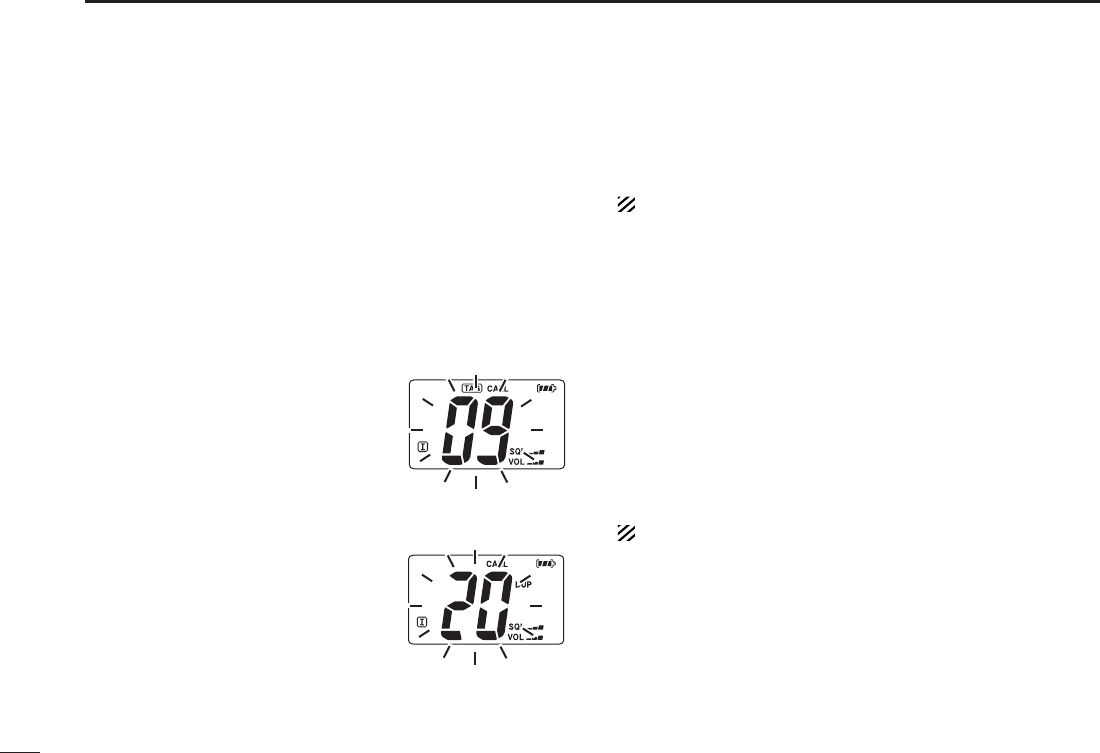
12
4BASIC OPERATION
■ Call channel programming
The Call channel is used to access Channel 9 (default).
However, you can program the Call channel with your most
often-used channel in each channel group, for quick recall.
q Hold down [U/I/C] (CH/WX) for 1 second, one or more
times, to select the desired channel group to be pro-
grammed (USA, International or Canada). (p. 9)
w Hold down [9] (16) for 1 second to select the Call channel
of the selected channel group.
• “CALL” and the Call channel number appear.
e Hold down [9] (16) again for 3 sec-
onds (until a long beep changes
to 2 short beeps) to enter the Call
channel programming mode.
• The channel number starts blinking.
r Push [Y] or [Z] to select the desired channel.
t Push [9] (16) to program the dis-
played channel as the Call channel.
• The channel number stops blinking.
■ Volume Loud function
The Volume Loud function temporarily maximizes the vol-
ume level.
This function has no effect when the volume level is 31.
q While holding down [VOL/SQL], push [Y] to turn ON the
Volume Loud function.
• The volume level is set to the maximum level (level 31).
• The bars of the volume level icon repeatedly appear in ascend-
ing order.
w Push [VOL/SQL] and [Y] again to turn OFF the Volume
Loud function.
■ Volume Mute function
The Volume Mute function temporarily mutes the audio out-
put.
This function has no effect when the volume level is OFF.
q While holding down [VOL/SQL], push [Z] to turn ON the
Volume Mute function.
• The volume level is set to the minimum level (OFF).
• The “VOL” icon blinks.
w Push [VOL/SQL] and [Z] again to turn OFF the Volume
Mute function.
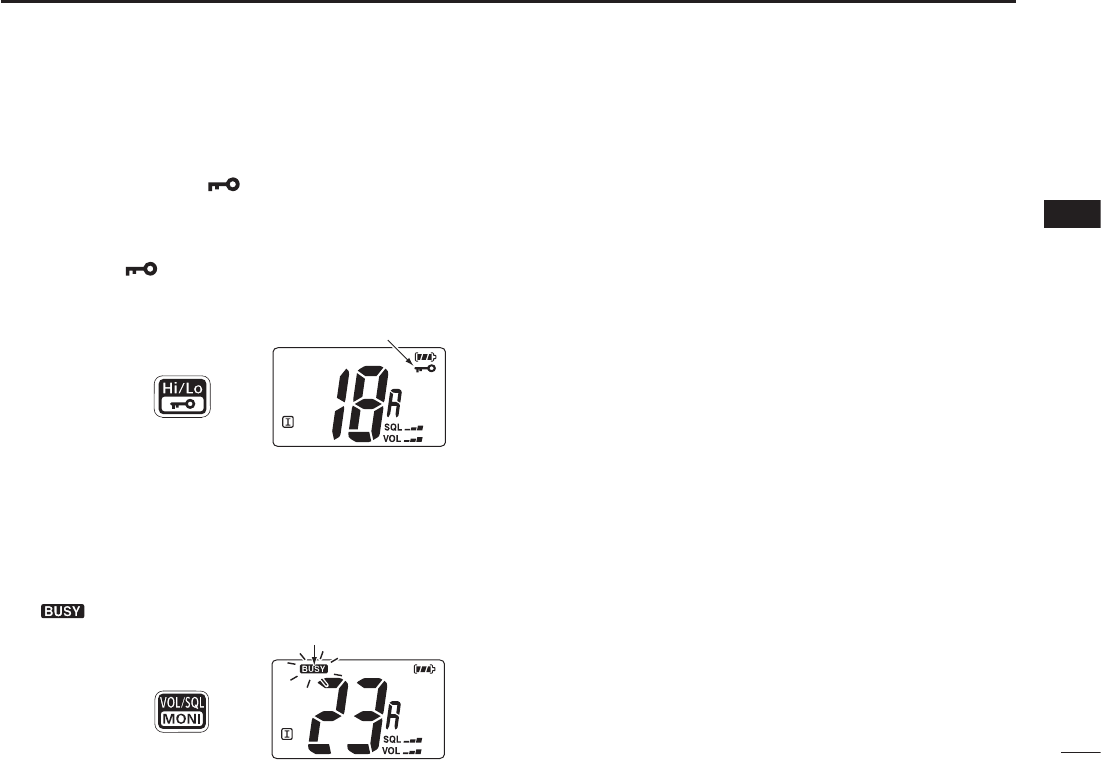
■ Lock function
This function electronically locks all keys (except for [PTT], [VOL/
SQL], [MONI] (VOL/SQL), [] (Hi/Lo) and [Y] or [Z]*) to pre-
vent accidental changing of the channel and function access.
* Only in the volume or squelch adjustment mode, and volume loud
and Volume Mute functions.
➥ Hold down
[ ]
(Hi/Lo) for 1 second to turn the Lock
function ON and OFF.
■ Monitor function
The Monitor function opens the squelch. The monitor key ac-
tion can be selected in the Set mode. (p. 19)
➥ The Monitor function is activated by holding down
[MONI]
(VOL/SQL)
.
• “ ” blinks and the squelch opens.
■ Automatic backlighting
This function lights the function display and keys, and is con-
venient for night-time operation. The automatic backlighting
can be activated in the Set mode. (p. 20)
➥ Push any key except for [PTT] to turn ON the backlight.
• The backlight is automatically turned OFF after 5 seconds of
inactivity.
■
AquaQuake Water Draining function
The AquaQuake Water Draining function removes water
from the speaker grill. Without this function, water may muffl e
the sound coming from the speaker. The transceiver makes
a vibrating sound when this function is activated.
➥ Hold down both [SCAN] and [Hi/Lo].
• A low vibration tone sounds for 9 seconds to drain water, re-
gardless of the volume level setting.
• The transceiver does not accept key operations while the
AquaQuake Water Draining function is activated.
13
4
BASIC OPERATION
1
2
3
4
5
6
7
8
9
10
11
12
13
14
15
16
Appears while the Lock function is activated.
Hold down
for 1 second
Blinks while the monitor function is activated.
Hold down
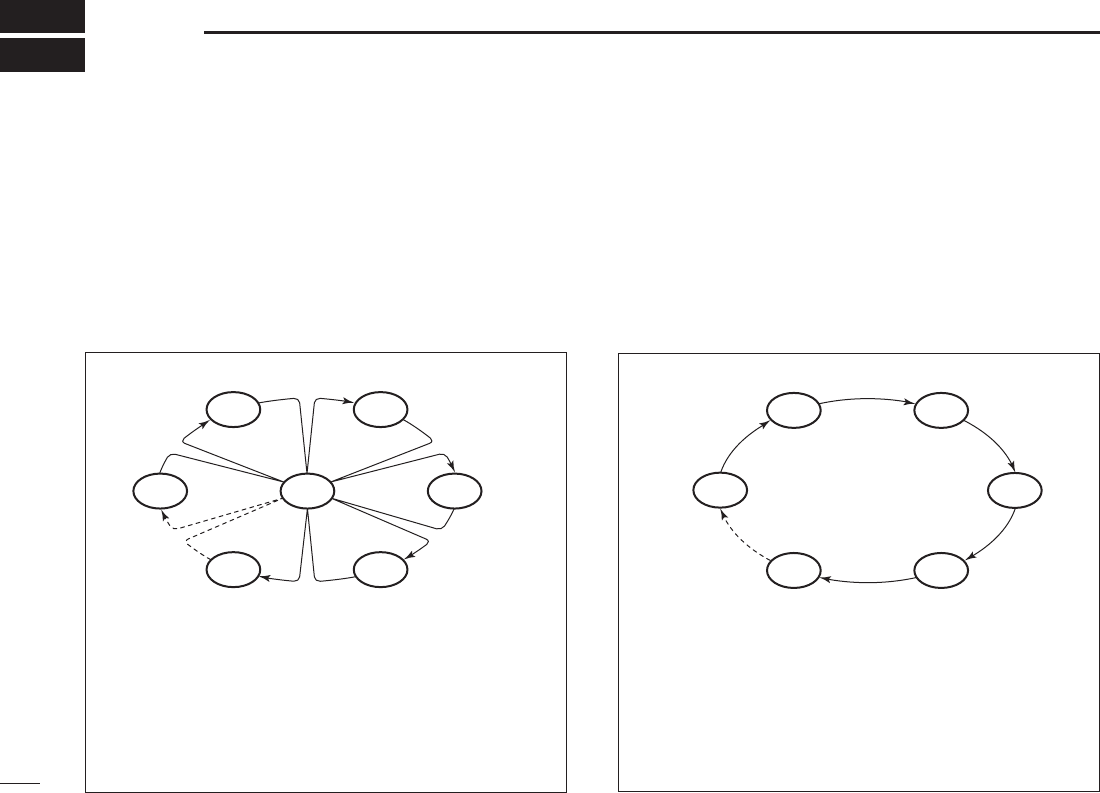
14
SCAN OPERATION
5
■ Scan types
Scanning is an effi cient way to quickly locate signals over a
wide frequency range. The transceiver has a priority scan
and a normal scan.
In addition, the Weather Alert and Auto Scan functions are
selectable for standby convenience. These functions can be
simultaneously activated, depending on the setting in the
Set mode. (pp. 18, 19)
Set the TAG channels (scanned channels) before scanning.
Clear the TAG for unwanted channels which inconveniently
stop scanning, such as those for digital communications. (p. 15)
Choose the desired scan type from "Priority" or "Normal" in
the Set mode. (p. 18)
PRIORITY SCAN
A priority scan sequentially searches through all TAG
channels while monitoring Channel 16. When a signal is
detected on Channel 16, the scan pauses until the signal
disappears; when a signal is detected on a channel other
than Channel 16, the scan switches to Dualwatch, until
the signal disappears.
NORMAL SCAN
A normal scan, like a priority scan, sequentially searches
through all TAG channels. However, unlike a priority scan,
Channel 16 is not checked unless Channel 16 is set as a
TAG channel.
WX*
CH 01
CH 16
CH 02
CH 05 CH 04
CH 03
Previously selected weather channel.
(when the Weather Alert function is activated)
*
CH 01 CH 02
WX*
CH 05 CH 04
CH 03
Previously selected weather channel.
(when the Weather Alert function is activated)
*
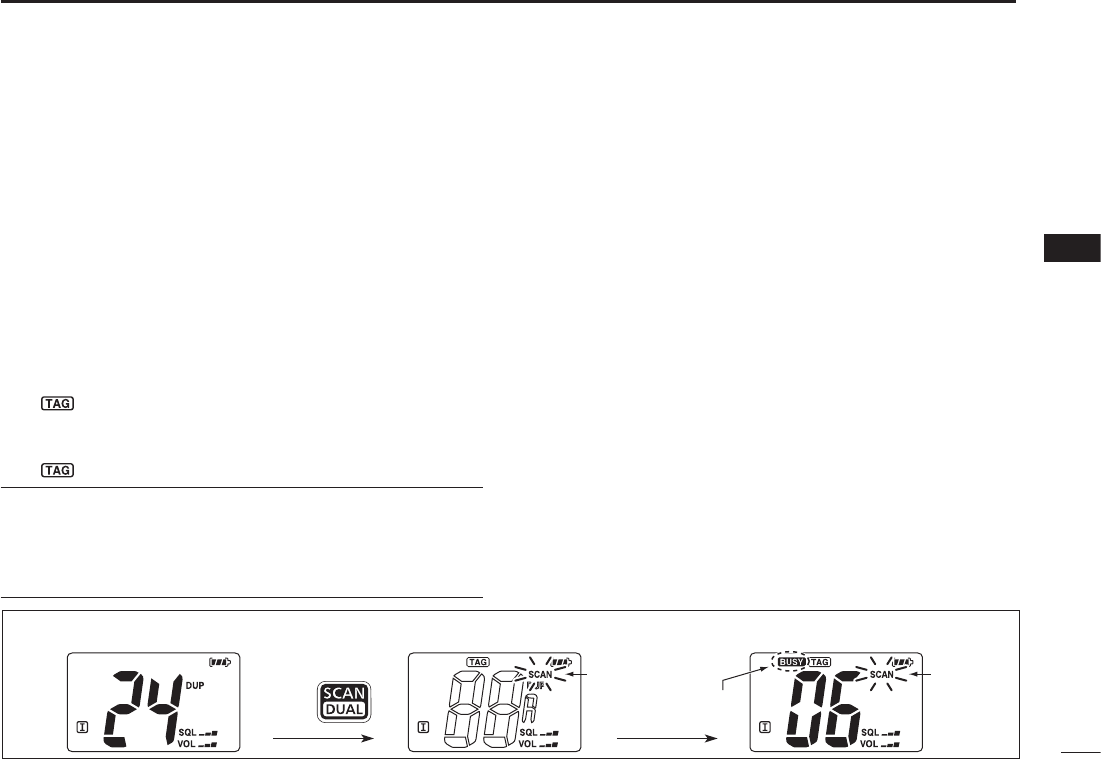
■ Setting TAG channels
For more efficient scanning, add the desired channels as
TAG channels, or clear the TAG on unwanted channels.
Channels that are not tagged will be skipped while scan.
TAG channels can be independently assigned to each USA,
International and Canada channel group.
q Hold down [U/I/C] (CH/WX) for 1 second one or more
times to select the desired channel group.
w Select the desired channel to be set as a TAG channel.
e Hold down [TAG] (FAV) for 1 second to set the displayed
channel as a TAG channel.
• “ ” appears on the display.
r
To cancel a TAG channel setting
, hold down
[TAG] (FAV) for
1 second.
• “ ” disappears.
✔ Clearing (or setting) all tagged channels
While holding down [TAG] (FAV), turn ON the power to clear
all TAG channels in the selected channel group.
• Repeat above procedure to set all channels as TAG channels
(when no TAG channel has been set.)
■ Starting a scan
Set the Weather Alert function, Priority Scan function, Scan
Resume Timer and Auto Scan function in advance, in the
Set mode. (pp. 18, 19)
q Hold down [U/I/C] (CH/WX) for 1 second one or more
times to select a desired channel group.
• When the Weather Alert function is in use, select a desired
weather channel using [CH/WX] and [Y] or [Z]. (p. 9)
w Push [SCAN] to start a priority or normal scan.
• “SCAN” blinks while scanning.
• “16” appears on the sub channel readout during a priority scan.
• When a signal is received, the scan pauses until the signal
disappears, or resumes after pausing 5 seconds, depending on
the Set mode setting.
• Push [Y] or [Z] to sequentially select TAG channels, change
the scanning direction or manually resume the scan.
e To stop the scan, push [SCAN] again.
• “SCAN” disappears.
• Pushing [PTT], [16], [CH/WX] or [FAV] also stops the scan.
15
5
SCAN OPERATION
1
2
3
4
5
6
7
8
9
10
11
12
13
14
15
16
[Example]: Starting a normal scan.
Push
Blinks Blinks
Scanning starts When a signal is received
Appears
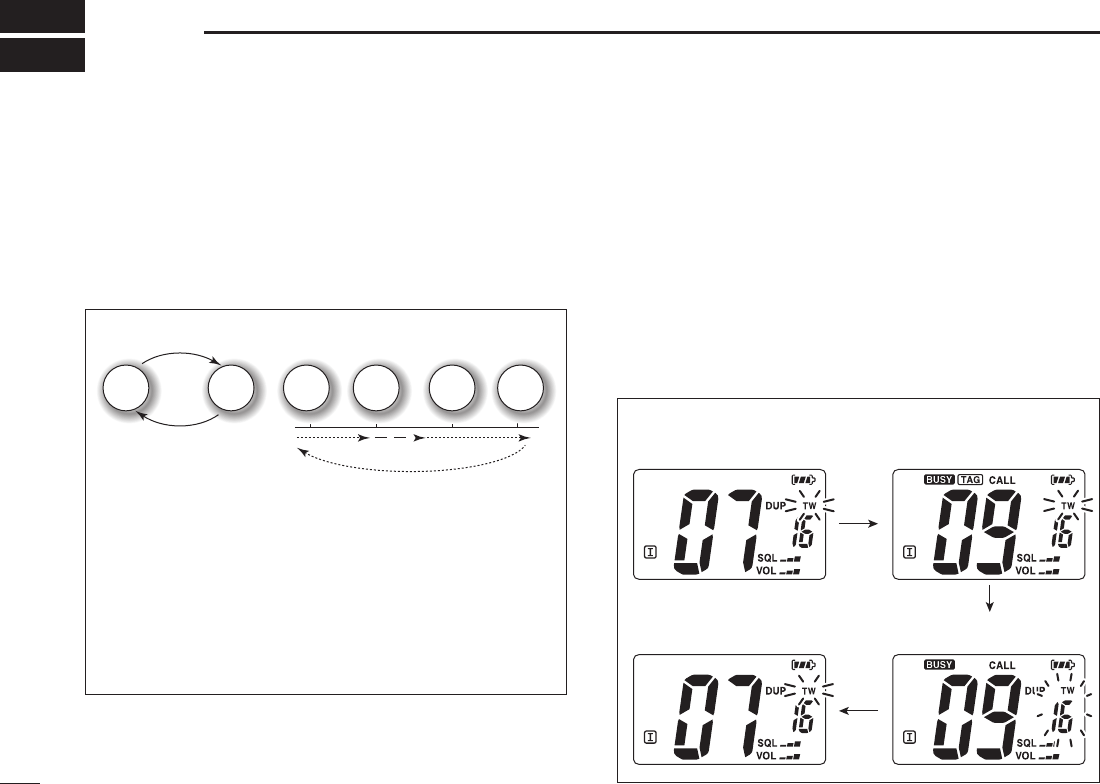
16
DUALWATCH/TRI-WATCH
6
■ Description
Dualwatch monitors Channel 16 while you are receiving
on another channel; Tri-watch monitors Channel 16 and the
Call channel while receiving another channel. Dualwatch/Tri-
watch are convenient for monitoring Channel 16 when you
are operating on another channel.
■ Operation
q Select Dualwatch or Tri-watch in the Set mode. (p. 19)
w Select the desired channel.
e
Hold down [DUAL] (SCAN) for 1 second to start Dual-
watch
or Tri-watch, depending on the Set mode setting.
• “DW” blinks during Dualwatch; “TW” blinks during Tri-watch.
• A beep tone sounds when a signal is received on Channel 16.
• Tri-watch switches to Dualwatch when receiving a signal on the
Call channel.
r
To cancel Dualwatch/Tri-watch, push [DUAL] (SCAN)
again.
• If a signal is received on Channel 16, Dualwatch/Tri-
watch pauses on Channel 16 until the signal disappears.
• If a signal is received on the Call channel during Tri-
watch, Tri-watch becomes Dualwatch until the signal dis-
appears.
• To transmit on the selected channel during Dualwatch/
Tri-watch, Hold down [PTT].
Dualwatch
DUALWATCH/TRI-WATCH SIMULATION
Tri-watch
Call
channel
Ch 88
Ch 16 Ch 88 Ch 16 Ch 88 Ch 9
[Example]: Operating Tri-watch on INT channel 07.
Tri-watch starts.
A signal is received on the
Call channel.
The signal received on
Channel 16 takes priority.
Tri-watch resumes after
the signal disappears.
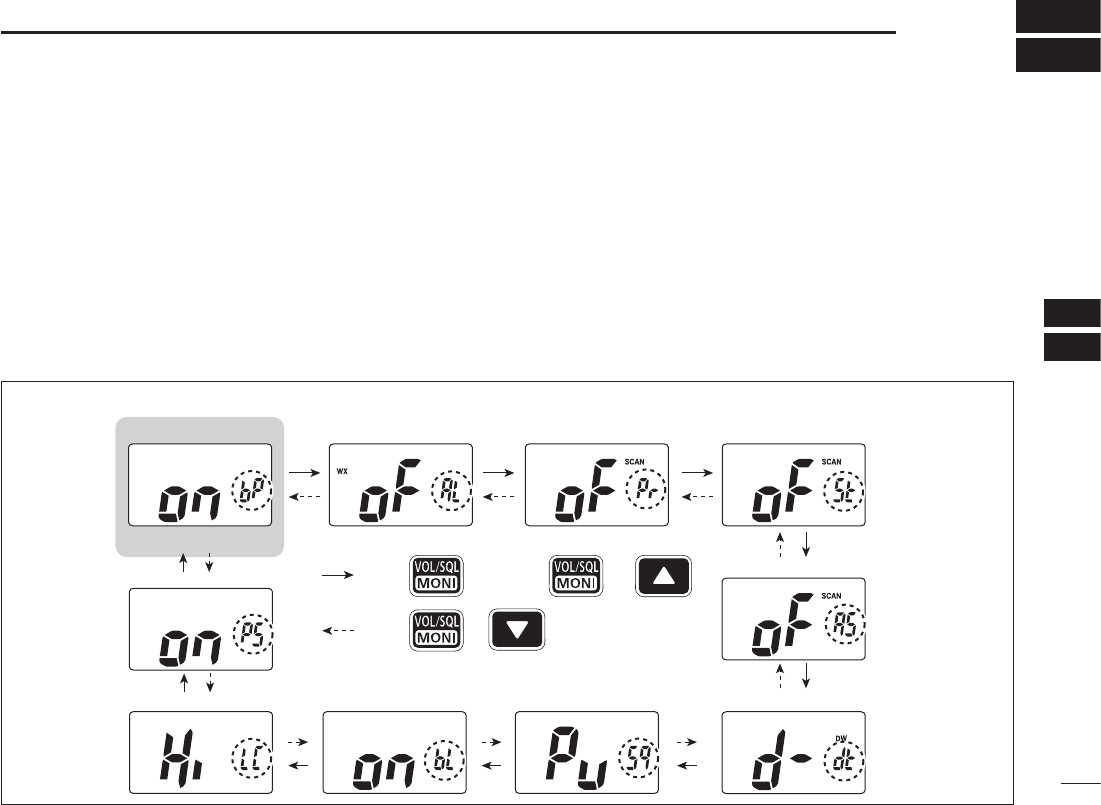
■ Set mode programming
The Set mode is used to change the settings of transceiver's
functions: Beep Tone function, Weather Alert function, Prior-
ity Scan function, Scan resume timer, Auto Scan function,
Dual/Tri-watch function, Monitor key action, Automatic back-
lighting, LCD contrast setting and Power Save function.
D Set mode operation
q Turn OFF the power.
w While holding down [VOL/SQL], turn ON the power to
enter the Set mode.
• “bP” appears.
e Push [VOL/SQL] to select a desired item. Or while holding
down [VOL/SQL], push [Y] or [Z] also selects an item.
r Push [Y] or [Z] to select a desired option of the item.
t To exit the Set mode, push [16].
17
7
SET MODE
1
2
3
4
5
6
7
8
9
10
11
12
13
14
15
16
SET MODE ITEMS (The display shows the current settings, and the selected item is displayed in the dotted circle.)
• Auto scan
Starting item
• Beep tone • Scan resume timer
• Dual/Tri-watch
• Automatic
backlighting
• Power save
• LCD contrast • Monitor key action
• Priority scan• Weather Alert
: Push +
: Push Push
or +
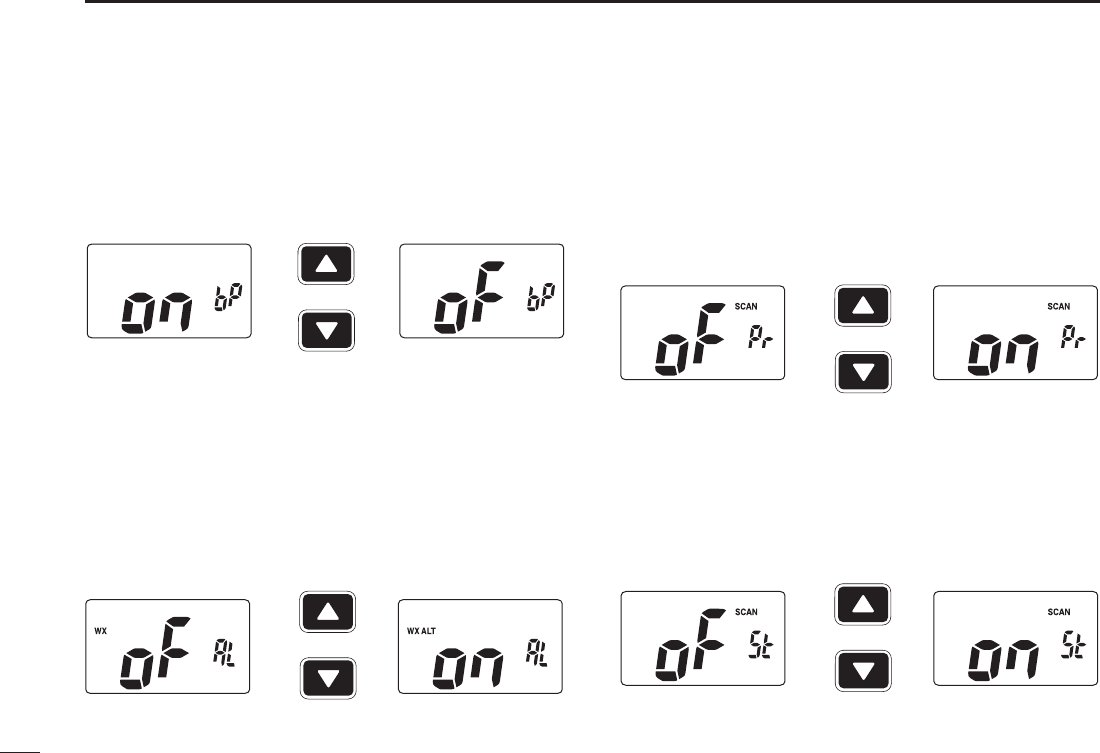
18
7SET MODE
■ Set mode items
D Beep Tone function “bP”
Turn the key touch beep sound ON or OFF.
• OFF : For silent operation.
• ON : A beep sounds.
D Weather Alert function “AL”
A NOAA broadcast station transmits a weather alert tone be-
fore any important weather announcements. When the func-
tion is turned ON and the transceiver detects a weather alert
tone, the “WX ALT” icon blinks and a beep sounds. The blink-
ing stops when an operation is performed.
The currently selected weather channel is checked while the
Power Save function is activated, or during a scan.
• “ALT” appears when the function is set to ON.
D Priority Scan function “Pr”
The transceiver has 2 scan types— normal (OFF) and pri-
ority (ON) scan. A normal scan searches all TAG channels
in the selected channel group. A priority scan sequentially
searches all TAG channels while monitoring Channel 16.
D Scan resume timer “St”
The Scan resume timer can be set as a pause (OFF) or
timer scan (ON).
• OFF : When a signal is detected, the scan pauses on the channel
until the signal disappears, and then resumes.
• ON : When a signal is detected, the scan pauses on the channel
for 5 seconds, and then resumes.
Bee
p
tone ON
(
default
)
Bee
p
tone OFF
Push
Weather Alert function
OFF (default)
Weather Alert function
ON
Push
Normal scan (default) Priority scan
Push
Scan resume timer OFF Scan resume timer ON
Push
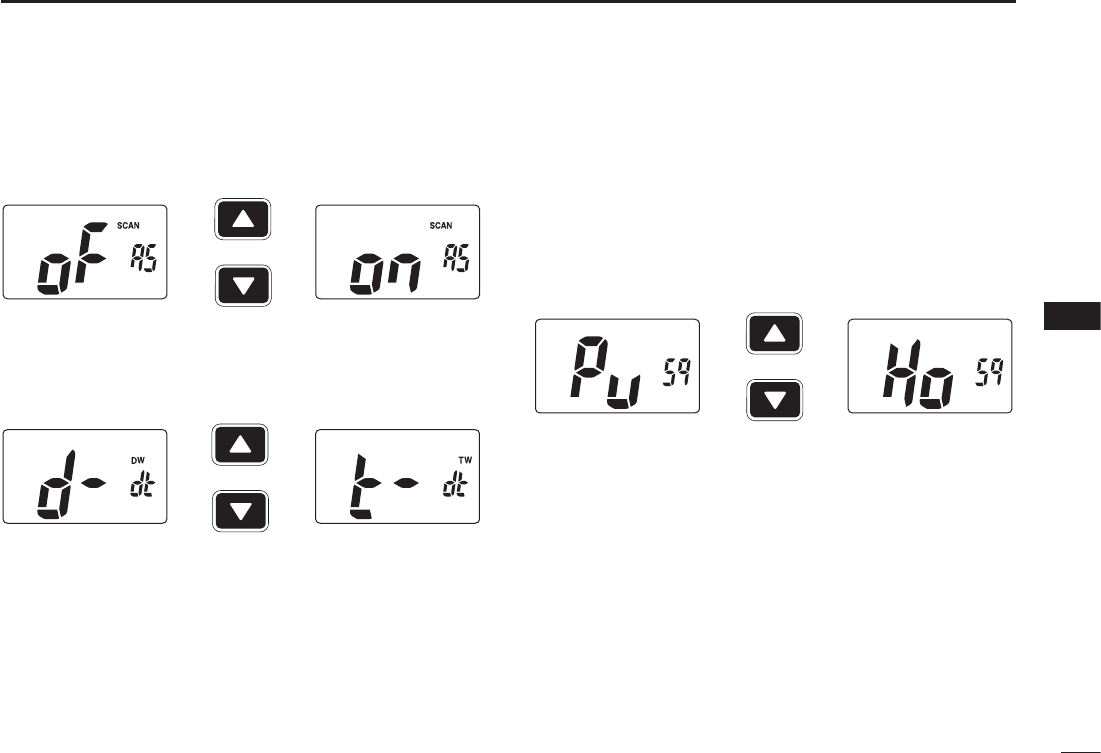
D Auto Scan function “AS”
The Auto Scan function automatically starts a normal or
priority scan when no signal is received, and no operation is
performed for 30 seconds.
D Dual/Tri-watch function “dt”
Set the watch type to Dualwatch or Tri-watch. (p. 16)
D Monitor key action “Sq”
The monitor key temporarily opens the squelch. This item sets
the key action.
• Pu (PUSH) : The Monitor function is activated by holding down
[MONI] (VOL/SQL). The squelch stays open while
holding down the key.
• Ho (HOLD) : The Monitor function is activated by holding down
[MONI] (VOL/SQL) for 1 second. The squelch stays
open until any key is pushed.
19
7
SET MODE
1
2
3
4
5
6
7
8
9
10
11
12
13
14
15
16
Auto scan OFF (default) Auto scan ON
Push
Dualwatch function
(default)
Tri-watch function
Push
Push setting (default) Hold setting
Push
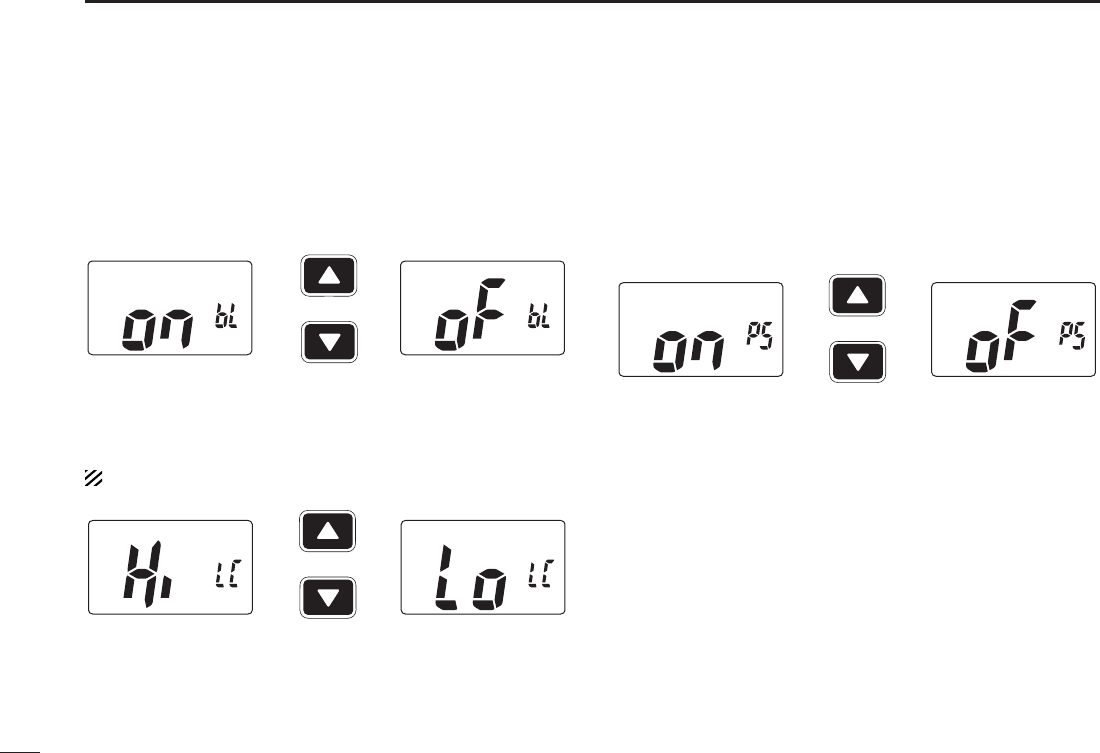
20
7SET MODE
D Automatic backlighting “bL”
This function is convenient for night-time operation. The
backlight can be selected from ON and OFF.
• The backlight is automatically activated when any key except
[PTT] is pushed.
• The backlight is automatically turned OFF after 5 seconds of inac-
tivity.
D LCD contrast setting “LC”
Set the LCD contrast level to High contrast or Low contrast.
The LCD contrast level has little effect during indoor use.
D Power Save function “PS”
The Power Save function reduces current drain by turning
OFF the receiver circuit for preset intervals.
• OFF : The Power Save function is turned OFF.
• ON : The Power Save function is turned ON. The Power Save
function will be activated when no signal is received, and no
operation is performed for 5 seconds
Auto backlighting ON
(default)
Auto backlighting OFF
Push
High contrast (default) Low contrast
Push
Power Save ON
(default)
Power Save OFF
Push
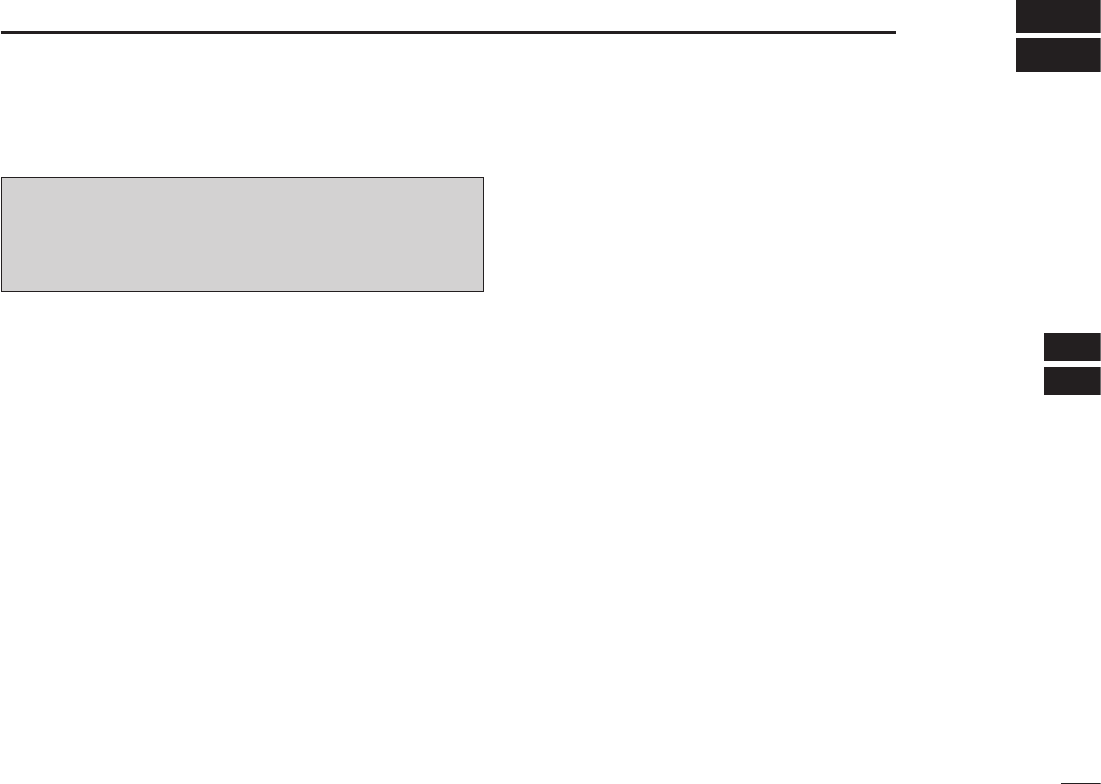
21
8
BATTERY CHARGING
1
2
3
4
5
6
7
8
9
10
11
12
13
14
15
16
■ Battery caution
R DANGER! Use and charge only specifi ed Icom battery pack with
Icom radios or Icom chargers. Only Icom battery packs are tested
and approved for use and charge with Icom radios or Icom chargers.
Using third-party or counterfeit battery packs or chargers may cause
smoke, fi re, or cause the battery to burst.
D Battery caution
R DANGER! DO NOT hammer or otherwise impact the battery. Do
not use the battery if it has been severely impacted or dropped, or if
the battery has been subjected to heavy pressure. Battery damage
may not be visible on the outside of the case. Even if the surface
of the battery does not show cracks or any other damage, the cells
inside the battery may rupture or catch fi re.
R DANGER! NEVER use or leave battery pack in areas with
temperatures above +50˚C (+122˚F). High temperature buildup in
the battery, such as could occur near fi res or stoves, inside a sun-
heated car, or by setting the battery in direct sunlight may cause the
battery to rupture or catch fire. Excessive temperatures may also
degrade battery performance or shorten battery life.
R DANGER! DO NOT expose the battery to rain, snow, saltwater,
or any other liquids. Never charge or use a wet battery. If the battery
gets wet, be sure to wipe it dry before using. The battery by itself is
not waterproof.
R DANGER! NEVER incinerate a used battery pack since internal
battery gas may cause them to rupture or may cause an explosion.
R DANGER! NEVER solder the battery terminals, or NEVER
modify the battery pack. This may cause heat generation, and the
battery may rupture, emit smoke or catch fi re.
R DANGER! Use the battery only with the transceiver for which it is
specifi ed. Never use a battery with any other equipment, or for any
purpose that is not described in this instruction manual.
R DANGER!
If fl uid from inside the battery gets in your eyes, blind-
ness can result. Rinse your eyes with clean water, without rubbing
them, and see a doctor immediately.WARNING! Immediately stop
using the battery if it emits an abnormal odor, heats up, or is discol-
ored or deformed. If any of these conditions occur, contact your Icom
dealer or distributor.
WARNING! Immediately wash, using clean water, any part of the
body that comes into contact with fl uid from inside the battery.
WARNING!
NEVER put the battery in a microwave oven, high-
pressure container, or in an induction heating cooker. This could cause
overheating, a fi re, or cause the battery to rupture.
CAUTION: Always use the battery within the specific temperature
range for the transceiver (–20˚C to +60˚C; –4˚F to +140˚F) and the
battery itself (–20˚C to +60˚C; –4˚F to +140˚F). Using the battery
out of its specifi c temperature range will reduce the battery’s perfor-
mance and battery life.
Misuse of Lithium-ion batteries may result in the follow-
ing hazards: smoke, fi re, or the battery may rupture.
Misuse can also cause damage to the battery or deg-
radation of battery performance.

22
8BATTERY CHARGING
■ Battery caution (continued)
CAUTION: Shorter battery life could occur if the battery is left fully
charged, completely discharged, or in an excessive temperature en-
vironment (above +60˚C; +140˚F) for an extended period of time. If
the battery must be left unused for a long time, it must be detached
from the radio after discharging. You may use the battery until the
remaining capacity is about half, then keep it safely in a cool dry
place with the temperature range as follows:
–20˚C to +50˚C (–4˚F to +122˚F) (within a month)
–20˚C to +35˚C (–4˚F to +95˚F) (within three months)
–20˚C to +25˚C (–4˚F to +77˚F) (within a year)
D Charging caution
Charge the battery pack at least once every six months, even if it
has been not used for a long period of time. The battery pack will
have slowly self-discharged, even though it has not been used. If the
battery pack is left for a long period without being charged, its life
cycle will be shorter, or worse, it will never accept a charge again.
Due to the characteristics of the Li-ion rectangular battery, the
battery pack may change its shape as the charge and discharge
cycles are repeated. This is a normal phenomenon, and it is quite
safe to continue to use the pack, as long as it is properly handled.
However, when the shape of the battery pack is so changed that
the battery pack or battery cover can not be correctly attached to
the transceiver, it is time to replace it with a new one. Otherwise, the
transceiver can be damaged due to the loss of air tightness.
R DANGER! NEVER charge the battery pack in areas with ex-
tremely high temperatures, such as near fires or stoves, inside
a sun-heated car, or in direct sunlight. In such environments, the
safety/protection circuit in the battery will activate, causing the bat-
tery to stop charging.
WARNING! DO NOT charge or leave the battery in the battery char-
ger beyond the specifi ed time for charging. If the battery is not com-
pletely charged by the specifi c time, stop charging and remove the
battery from the battery charger. Continuing to charge the battery
beyond the specifi c time limit may cause a fi re, overheating, or the
battery may rupture.
WARNING! NEVER insert the transceiver (battery attached to the
transceiver) into the charger if it is wet or soiled. This could corrode
the battery charger terminals or damage the charger. The charger is
not waterproof.
CAUTION: DO NOT charge the battery outside of the specified
temperature range: ±0˚C to +45˚C (+32˚F to +113˚F). Icom recom-
mends charging the battery at +20˚C (+68˚F). The battery may heat
up or rupture if charged out of the specifi ed temperature range, and
battery performance or battery life may be reduced.
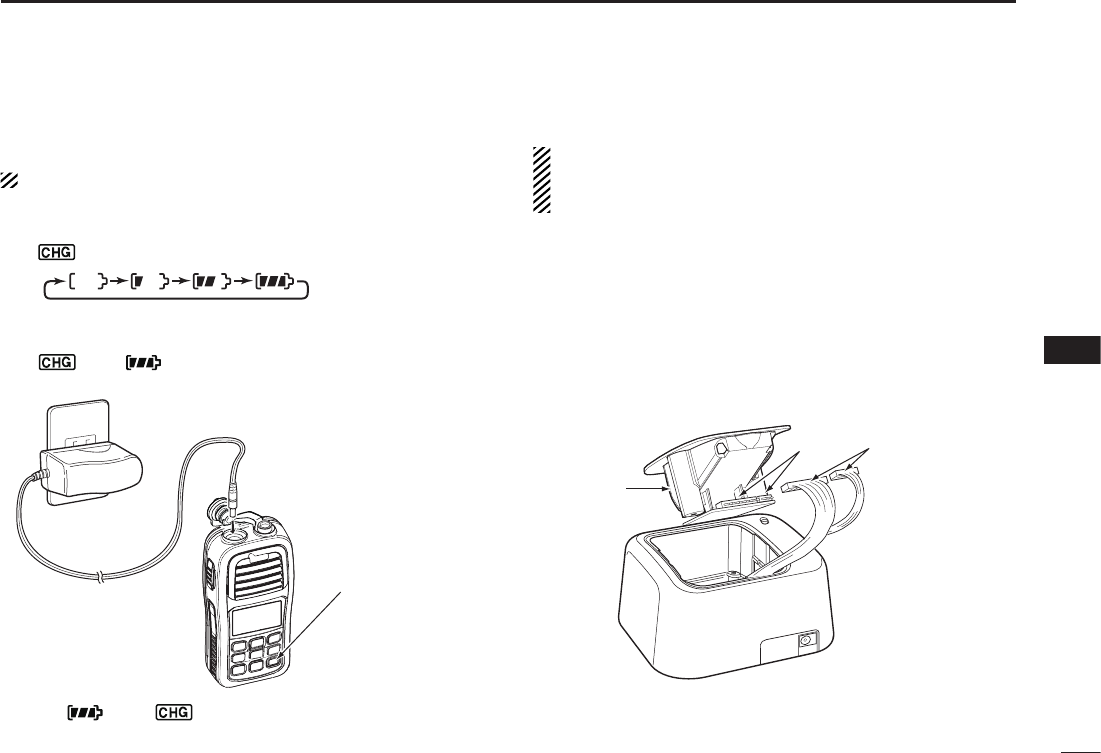
23
8
BATTERY CHARGING
1
2
3
4
5
6
7
8
9
10
11
12
13
14
15
16
■ Supplied battery charger
D Charging
Do not use a charger other than the specifi ed one.
q Turn OFF the transceiver's power.
w Connect the charger as shown below.
• “ ” appears, and the battery icon scrolls while charging.
e The charging is completed in approximately 8.5 hours,
depending on the remaining capacity before charging.
• “” and “ ” appear, and “FL” is also displayed on the
function display when charging is completed.
Charger
[DC] jack
Power OFF
BP-266
BP-266
BP-266
NOTE: “ ” and “ ” blink, and “Er” is also displayed on
the function display, when the battery pack is not attached.
■ Optional battery charger
Do not place the charger on a surface with any vibration.
Otherwise the battery pack might come out of the
charger, or the charger itself might fall.
D AD-123 installation
The AD-123 CHARGER ADAPTER must be installed into the
BC-119N DESKTOP CHARGER or BC-121N MULTI-CHARGER
before charging.
q Connect the AD-123 and the BC-119N or BC-121N as
shown.
BP-266
BP-266
BP-266
AD-123
BP-266
BP-266
Plugs
Sockets
This illustration is for the BC-119N.
BP-266
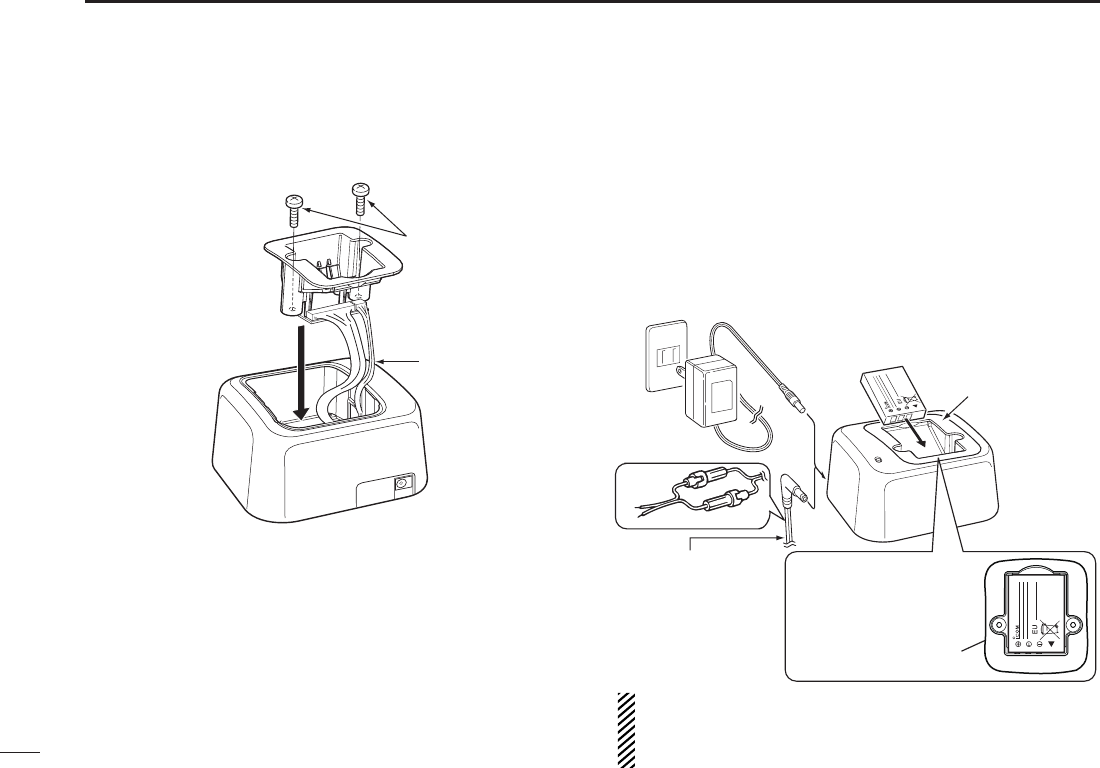
24
8BATTERY CHARGING
D AD-123 installation (continued)
w Install the AD-123 into the holder space of the BC-119N
or BC-121N with the supplied screws as shown.
D Charging
• For BC-119N
The optional BC-119N provides rapid charging of the Li-ion
battery pack.
Charging time: Approximately 2.5 hours
The following items are additionally required:
• AD-123 CHARGER ADAPTER (purchase separately)
• An AC adapter (may be supplied with BC-119N depending on ver-
sion) or the DC power cable (OPC-515L/CP-23L).
xx
AD-123 charger adapter is
installed in the BC-119N.
Optional OPC-515L
(for 13.8 V power
source) or CP-23L
(for 12 V cigarette
lighter socket) can
be used instead of
the AC adapter.
See the instruction manual for details of
the charger, LED indication,
operation, etc.
IMPORTANT!:
Ensure the battery pack
snaps flat in the AD-123.
BP-266
BC-119N
BP-266
BP-266
BP-266
BP-266
AD-123
AC adapter
BP-266
White: +
Black: _
BP-266
BP-266
Screws supplied with
the charger adapter
Carefully fold the
cables, as you set
the adaptor in place
This illustration is for the BC-119N.
BP-266
CAUTION: When using the OPC-515L DC power cable
NEVER reverse the polarity of an OPC-515L connected between
a power source and the battery charger. This will ruin the charger.
White line: + Black line: –
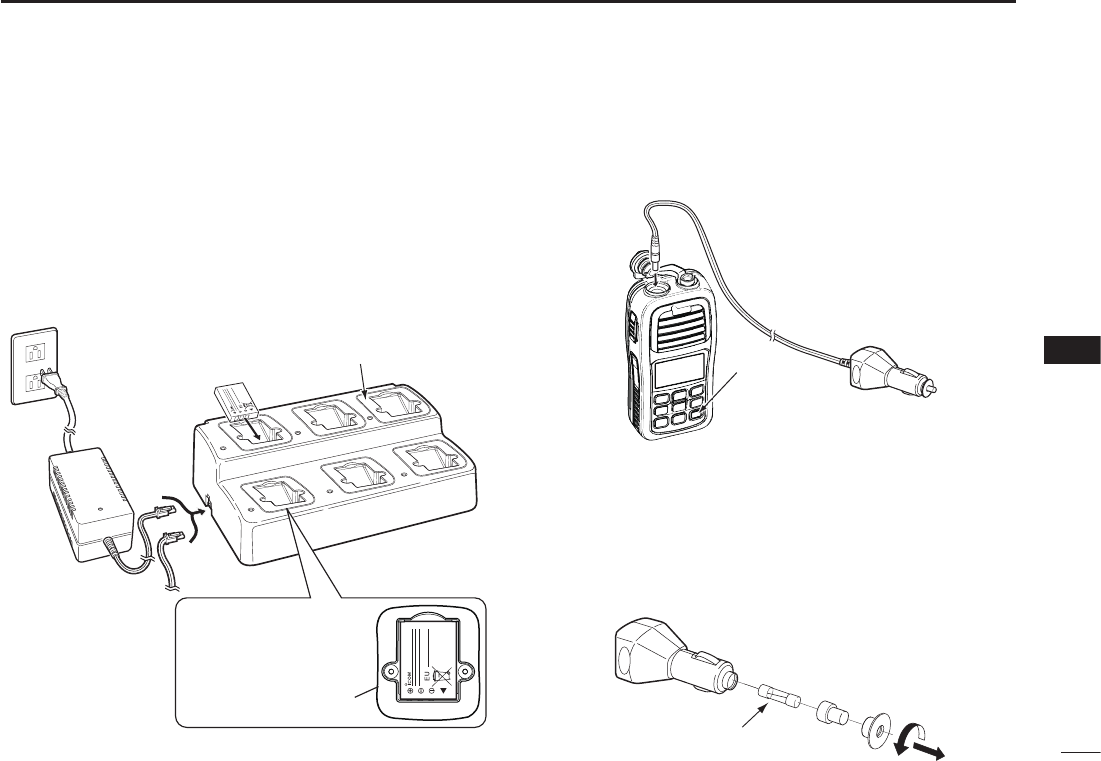
25
8
BATTERY CHARGING
1
2
3
4
5
6
7
8
9
10
11
12
13
14
15
16
AD-123 charger
adapters are installed
in each slot.
AC adapter
(Purchased
separately)
DC power cable (OPC-656)
(Connect to a DC
power supply;
13.8 V/at least 7 A)
xx
See the instruction manual
for details of the charger,
LED indication,
operation, etc.
BP-266
BP-266
BP-266
BP-266
IMPORTANT!:
Ensure the battery pack
snaps flat in the AD-123.
AD-123
BP-266
BP-266
BP-266
BC-121N
• For BC-121N
The optional BC-121N allows up to six battery packs to be
charged simultaneously.
Charging time: Approximately 2.5 hours
The following items are additionally required.
• Six AD-123 CHARGER ADAPTERS (purchase separately)
•
An AC adapter or the DC power cable (OPC-656)
D Charging from a cigarette lighter socket
Use the optional CP-24 CIGARETTE LIGHTER CABLE charge
from a cigarette lighter socket.
Charging time: Approximately 8.5 hours.
• CAUTION: BE SURE to remove the CP-24 from the ciga-
rette lighter socket when charging is finished, because a
slight current still fl ows in the CP-24 and will drain the ve-
hicle’s battery.
• The CP-24 is equipped with a 2 A fuse. If the fuse blows, de-
termine and fi x the problem, then replace it with a new rated
fuse.
BP-266
BP-266
BP-266
[DC] jack
Power OFF
To a cigarette lighter
socket (12/24 V DC)
CP-24
Fuse (2 A /250 V)
BP-266
BP-266
BP-266
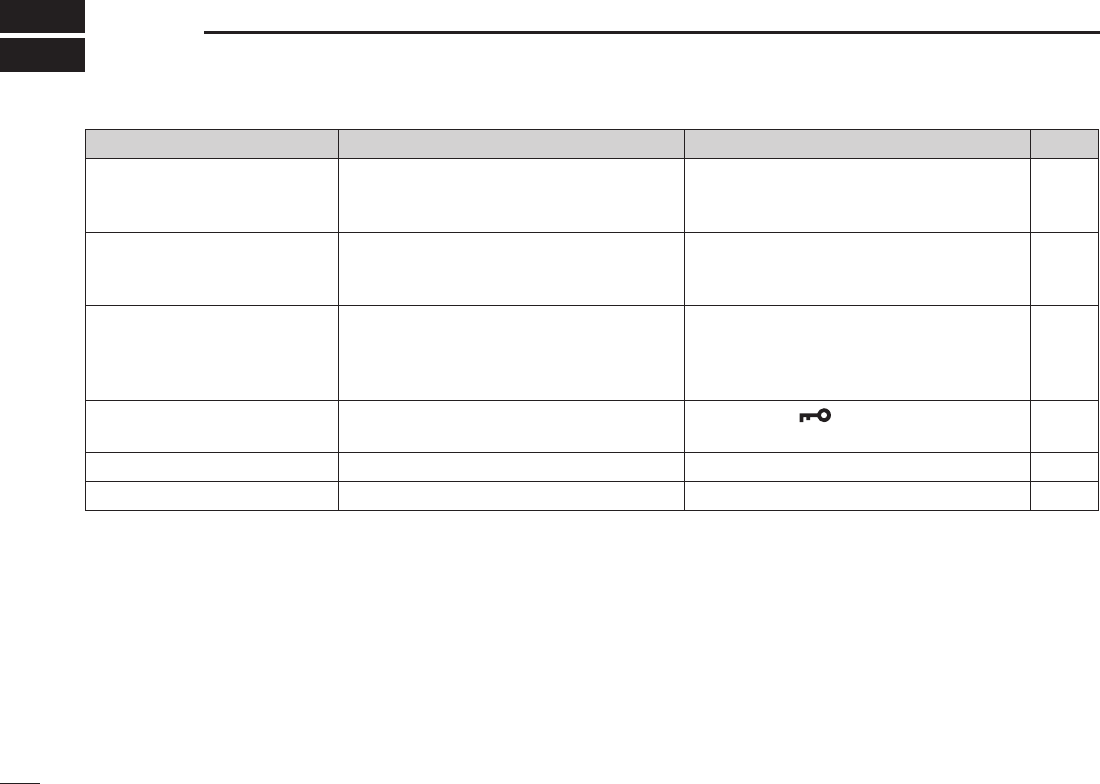
26
TROUBLESHOOTING
9
PROBLEM POSSIBLE CAUSE SOLUTION REF.
The transceiver does not turn
ON.
• The battery is exhausted.
• The battery pack is not correctly in-
serted.
• Recharge the battery pack.
• Correctly insert the battery pack.
p. 23
p. 3
No sound from speaker. • The squelch level is too high.
• Volume level is too low.
• Speaker has been exposed to water.
• Set the
squelch
level to the
threshold
level.
• Adjust the audio level to a suitable level.
• Remove water from the speaker grill.
p. 10
p. 10
p. 13
Transmitting is impossible,
or high power can not be se-
lected.
• Some channels are limited to low power
or only receive.
• The output power is set to low.
• The battery is exhausted.
• Change the channel.
• Push [Hi/Lo] to select high power.
• Recharge the battery pack.
pp. 8,
9, 27
p. 11
p. 23
The displayed channel cannot
be changed.
• The Lock function is activated. • Hold down [] (Hi/Lo) for 1 second to
turn OFF the function.
p. 13
Scan does not start • “TAG” channels are not programmed. •
Set desired channels as “TAG” channels.
p. 15
No beep sounds. • Beep Tone function is turned OFF. • Turn ON the Beep Tone in the set mode. p. 18
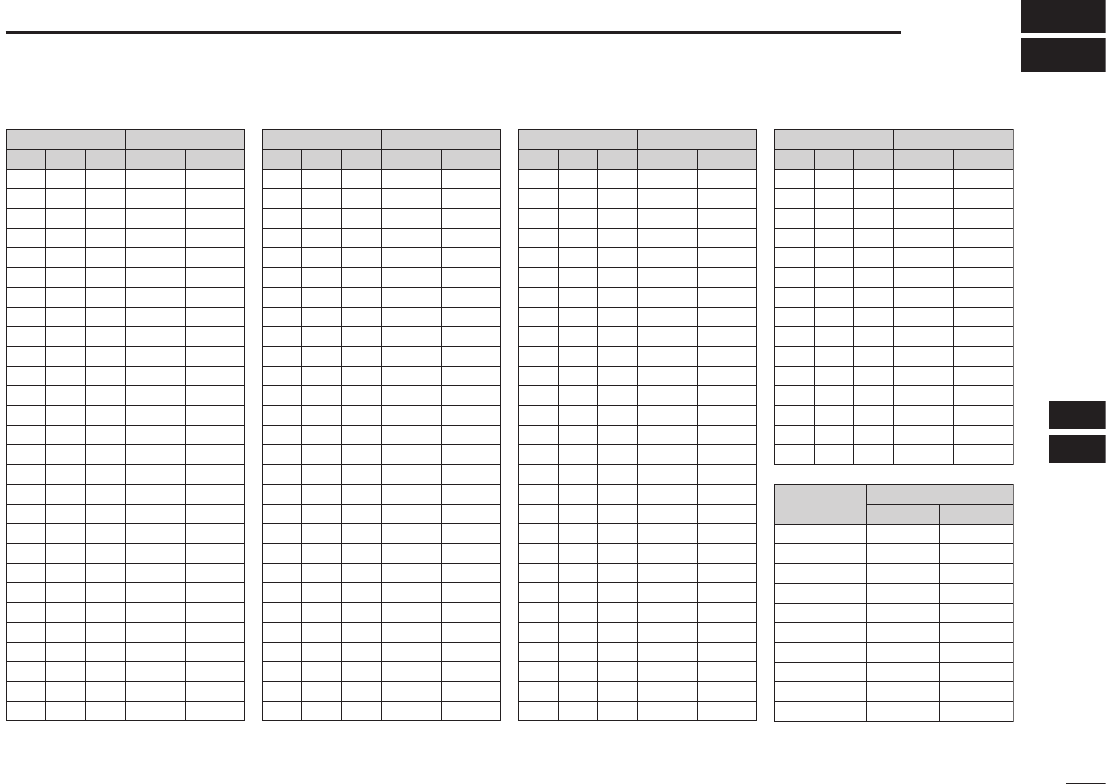
27
10
VHF MARINE CHANNEL LIST
1
2
3
4
5
6
7
8
9
10
11
12
13
14
15
16
NOTE: Simplex channels, 3, 21, 23, 61, 64, 81, 82 and 83 CANNOT
be lawfully used by the general public in U.S.A. waters.
*
Low power only.
Channel number Frequency (MHz)
03 156.150 160.75003
03A 156.150 156.150
156.200 160.80004
02 156.100 160.70002
04A 156.200 156.200
156.250 160.85005
05A 05A 156.250 156.250
06 06 156.300 156.30006
156.350 160.95007
07A 07A 156.350 156.350
08 08 156.400 156.40008
09 09 156.450 156.45009
10 10 156.500 156.50010
11 11 156.550 156.55011
12 12 156.600 156.60012
13* 13*
156.650 156.650
13
14 14
156.700 156.700
14
15* 15*
156.750 156.750
15*
16 16
156.800 156.800
16
17* 17*
156.850 156.850
17
156.900 161.500
18
18A 18A
156.900 156.900
156.950 161.550
19
19A 19A 156.950 156.950
20 20* 157.000 161.60020
20A 157.000 157.000
01A 156.050 156.050
USA
01
156.050 160.65001
CAN
Transmit Receive
INT
Channel number Frequency (MHz)
157.100 161.70022
22A 22A 157.100 157.100
23 157.150 161.75023
21b Rx only 161.650
23A 157.150 157.150
24 24 157.200 161.80024
25 25 157.250 161.85025
25b Rx only 161.850
26 26 157.300 161.90026
27 27 157.350 161.95027
28 28 157.400 162.00028
28b Rx only 162.000
60 156.025 160.62560
156.075 160.67561
61A 61A 156.075 156.075
156.125 160.72562
62A 156.125 156.125
156.175 160.77563
63A 156.175 156.175
64 156.225 160.82564
64A 64A 156.225 156.225
156.275 160.87565
65A 65A 156.275 156.27565A
156.325 160.92566
66A 66A* 156.325 156.32566A
67* 67 156.375 156.37567
21A 21A 157.050 157.050
USA
21 157.050 161.65021
CAN
Transmit Receive
INT
Channel number Frequency (MHz)
71 71 156.575 156.57571
72 72 156.625 156.62572
73 73 156.675 156.67573
70 70 RX only 156.52570
74 74 156.725 156.72574
75* 75* 156.775 156.77575*
76* 76* 156.825 156.82576*
77* 77* 156.875 156.87577
156.925 161.52578
78A 78A 156.925 156.925
156.975 161.57579
79A 79A 156.975 156.975
157.025 161.62580
80A 80A 157.025 157.025
157.075 161.67581
81A 81A 157.075 157.075
157.125 161.72582
82A 82A 157.125 157.125
83 157.175 161.77583
83A 83A 157.175 157.175
83b Rx only 161.775
84 84 157.225 161.82584
84A 157.225 157.225
85 85 157.275 161.87585
85A 157.275 157.275
86 86 157.325 161.92586
69 69 156.475 156.47569
68
USA
68 156.425 156.42568
CAN
Transmit Receive
INT
Channel number Frequency (MHz)
88 88 157.425 162.02588
88A 88A 88A 157.425 157.425
87A 87A 87A 157.375 157.375
87 87 157.375 161.97587
86A
USA
157.325 157.325
CAN
Transmit Receive
INT
Frequency (MHz)
RX only 162.425
RX only 162.450
RX only 162.500
RX only 162.475
RX only 162.525
RX only 161.650
RX only 161.775
RX only 163.275
RX only 162.400
RX only 162.550
Transmit Receive
WX channel
4
5
6
3
7
8
9
10
2
1
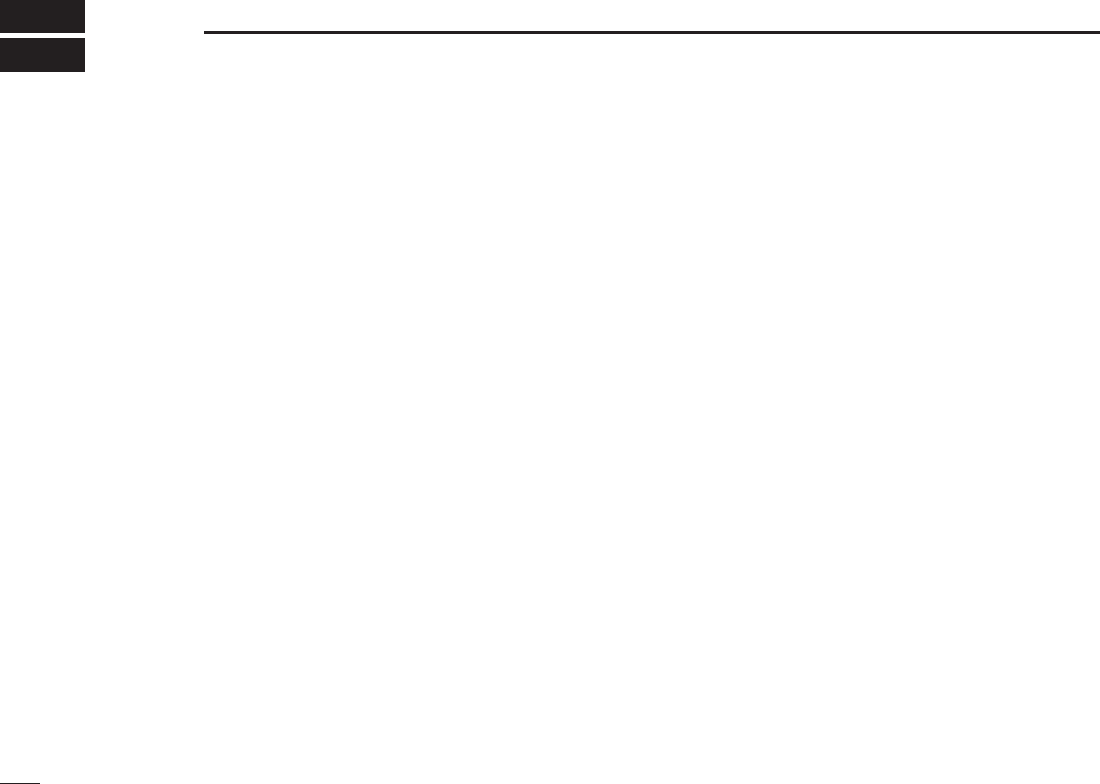
28
SPECIFICATIONS AND OPTIONS
11
■ Specifi cations
D GENERAL
• Frequency coverage : Transmit 156.025–157.425 MHz
Receive 156.050–163.275 MHz
• Mode : FM (16K0G3E)
• Power supply requirement : BP-266 only
• Current drain (approximately) : TX (5 W/1.0 W) 2.3 A/0.9 A
Max. audio
0.35 A typical
Power save 8 mA typical
• Frequency stability : ±10 ppm
• Operating temperature range : –20°C to +60°C; –4°F to +140°F
• Dimensions : 58.5 (W) × 128.5(H) × 34.5(D) mm
(projections not included) 25⁄16(W) × 519⁄32(H) × 111⁄32(D) inch
• Weight : Approximately 260 g; 9.2 oz
(including battery pack, antenna and belt clip)
D TRANSMITTER
• Output power : 5 W (approximately; High) and 1 W (Low)
• Modulation system : Variable reactance frequency modulation
• Maximum frequency deviation : ±5 kHz
• Adjacent channel power : 70 dB
• Spurious emissions : –68 dBc typical
• Residual modulation : 40 dB
• Audio frequency response : +1 dB to –3 dB of 6 dB oct. from 300–3000 Hz
D RECEIVER
• Receive system : Double-conversion superheterodyne
• Intermediate frequency : 1st 21.7 MHz, 2nd 450 kHz
• Sensitivity (12 dB SINAD) : 0.25 µV typical
• Squelch sensitivity : 0.35 µV typical (at threshold)
• Intermodulation : 70 dB typical
• Spurious response : 70 dB typical
• Adjacent channel selectivity : 70 dB typical
• Audio output impedance : 8 Ω
• Audio output power : 0.6 W typical (at 10% distortion)
All stated specifi cations are subject to change without notice or obligation.
■ Options
D BATTERY PACK
• BP-266 Li-ion BATTERY PAC K
Voltage/Capacity : 3.7 V/1500 mAh (minimum), 1590 mAh (typical)
D CHARGERS
• BC-199S AC ADAPTER
For regular charging of the battery pack.
Charging time : Approximately 8.5 hours
• BC-119N DESKTOP CHARGER + AD-123 CHARGER ADAPTER
+ BC-145S AC ADAPTER
For rapid charging of the battery pack. The AC adapter, BC-145S, is not sup-
plied with some versions.
Charging time : Approximately 2.5 hours
•
BC-121N MULTI-CHARGER + AD-123 CHARGER ADAPTER + BC-157S AC ADAPTER
For simultaneously rapid charging up to six battery packs (six AD-123s are
required). An AC adapter must be separately purchased.
Charging time : Approximately 2.5 hours
D OTHER OPTIONS
• FA-SC58V ANTENNA
• MB-124 BELT CLIP
• CP-24 CIGARETTE LIGHTER CABLE
• CP-23L CIGARETTE LIGHTER CABLE
For BC-119N
• OPC-515L DC POWER CABLE
For BC-119N
Approved Icom optional equipment is designed for optimal performance when
used with an Icom transceiver. Icom is not responsible for the destruction or
damage to an Icom transceiver in the event the Icom transceiver is used with
equipment that is not manufactured or approved by Icom.
Some options may not be available in some countries. Please ask your dealer
for details.
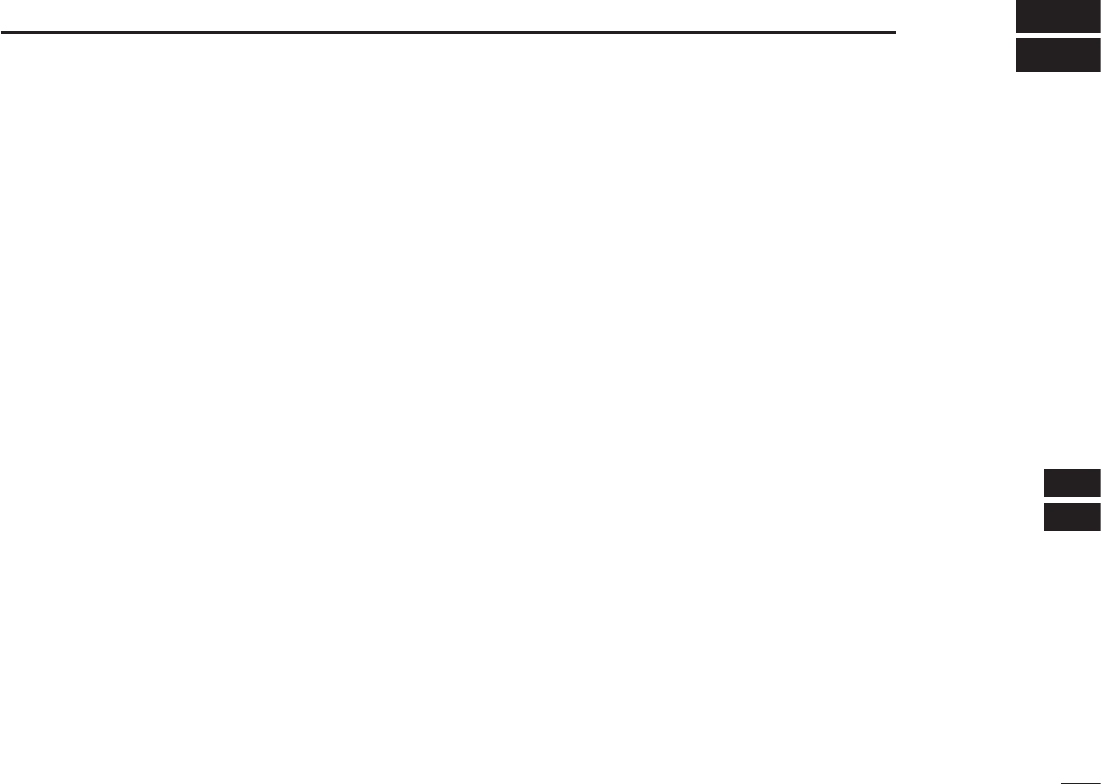
29
12
FCC INFORMATION
1
2
3
4
5
6
7
8
9
10
11
12
13
14
15
16
FOR CLASS B UNINTENTIONAL RADIATORS
This equipment has been tested and found to comply with
the limits for a Class B digital device, pursuant to part 15 of
the FCC Rules. These limits are designed to provide reason-
able protection against harmful interference in a residential
installation. This equipment generates, uses and can radiate
radio frequency energy and, if not installed and used in ac-
cordance with the instructions, may cause harmful interfer-
ence to radio communications. However, there is no guaran-
tee that interference will not occur in a particular installation.
If this equipment does cause harmful interference to radio
or television reception, which can be determined by turning
the equipment off and on, the user is encouraged to try to
correct the interference by one or more of the following mea-
sures:
• Reorient or relocate the receiving antenna.
• Increase the separation between the equipment and re-
ceiver.
• Connect the equipment into an outlet on a circuit different
from that to which the receiver is connected.
• Consult the dealer or an experienced radio/TV technician
for help.
CAUTION: Changes or modifi cations to this device, not
expressly approved by Icom Inc., could void your authority to
operate this device under FCC regulations.
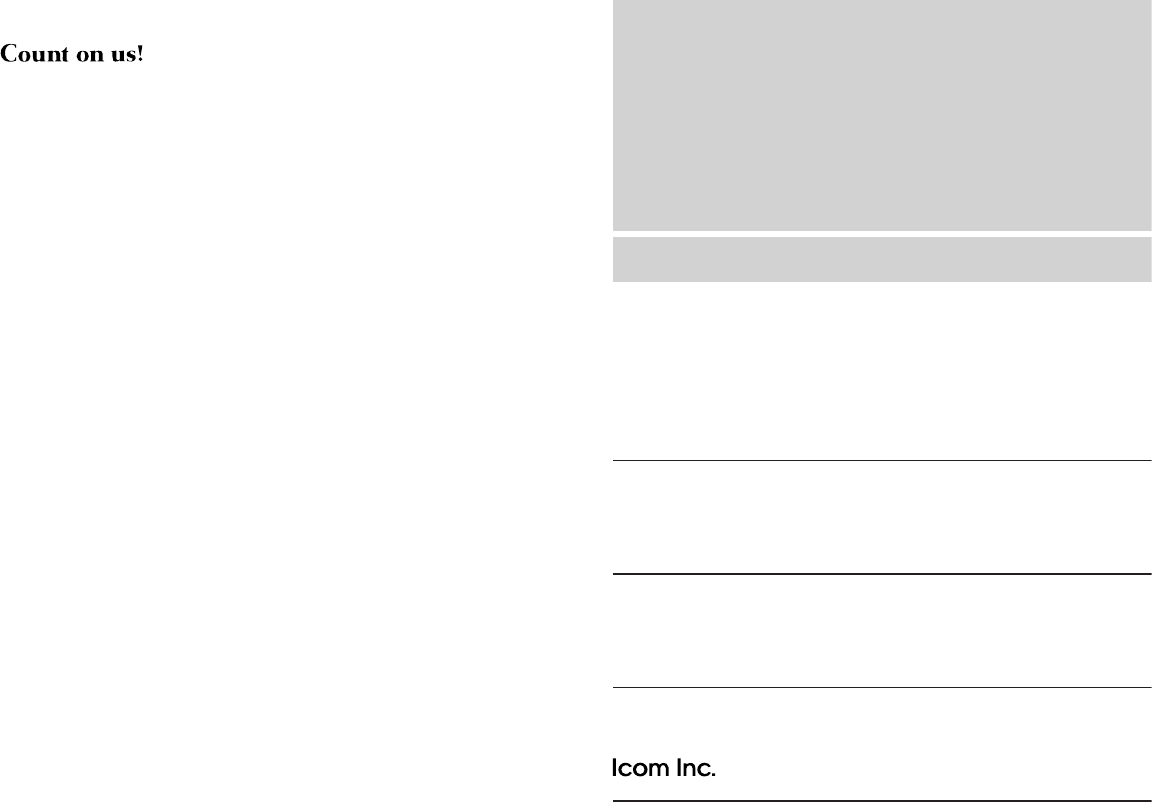
1-1-32 Kamiminami, Hirano-ku, Osaka 547-0003, Japan
A-6911H-1EX-q
Printed in Japan
© 2011 Icom Inc.
Printed on recycled paper with soy ink.